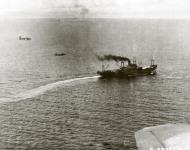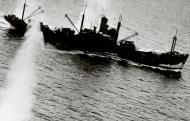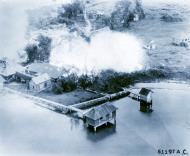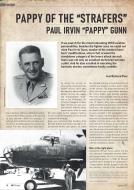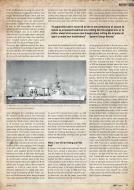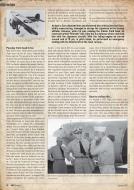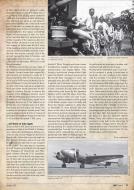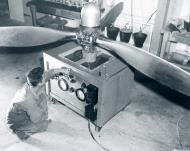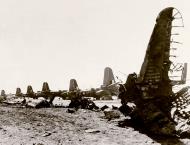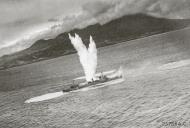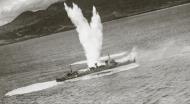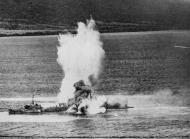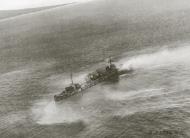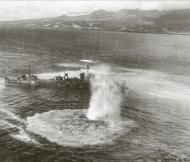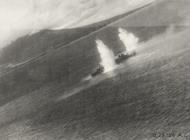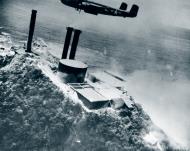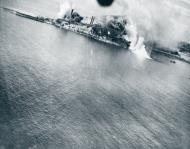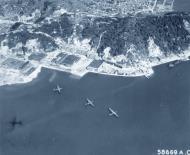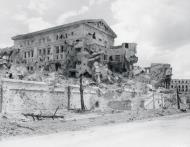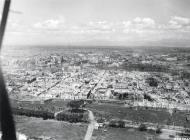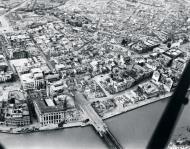Pacific Theater of Operations PTO B-25 Mitchell photo's gallery
4th Air Depot based at Garbutt Field Townsville was a major repair center in Australia 13th Dec 1943 NA604
4th Air Depot based at Garbutt Field Townsville was a major repair center in Australia 13th Dec 1943 NA600
Photo description: NA604 Hard standing No. 4 taken from edge of 67 degree runway, Garbutt Field, Townsville, Australia. 13 December 1943. (U.S. Air Force Number B80122AC); Hard standing adjacent to 130 degree runway near main repair depot at Garbutt Field, Townsville, Australia. 13 December 1943. (U.S. Air Force Number 80122AC)
Photo Source: National Archives Identifier NA604 NAID: 204948741 Local ID: 342-FH-3A29898-B80122AC
Photo Source: National Archives Identifier NA600 NAID: 204948735 Local ID: 342-FH-3A29896-80122AC
4th Air Depot with two Bell P-400s at Garbutt Field Townsville Australia 4th Dec 1942 NA600
Photo description: South End Of Hangar Of Air Force Project No. 1, 4Th Air Depot At An Airfield In Townsville, Australia. 4 December 1942. (U.S. Air Force Number 77837AC)
Photo Source: National Archives Identifier NAID: 204949039 Local ID: 342-FH-3A29890-77837AC
Propellor Maintenance done at Garbutt Field Townsville Australia 19th May 1943 NA655
Photo description: Pvt. Donald H. Fraser of Northfield, Minn., observes for leakage in a hydromatic test to see if the propellers are functioning properly at the 4th Air Depot engine overhaul and repair shop at Garbutt Field, Townsville, Australia. 19 May 1943. (U.S. Air Force Number 79938AC)
Photo Source: National Archives Identifier NAID: 204948816 Local ID: 342-FH-3A29929-79938AC
43-36201 B-25J Mitchell 13AF Jungle Air Force 43BG bomb Sandakan Jap port in Northern Borneo NA094
Photo description: A North American B-25 Billy Mitchell (lower right) of the 13th AAF, 'the jungle air force' banks sharply to the left after dropping a bomb accurately on dock housing at Sandakan, Japanese supply and ship-building center of Northern Borneo. This type of minimum-altitude work by the "Fightin' 13th’s" planes has cost the Japs throughout Borneo, the Celebes and the Molucca Islands.
Photo Source: National Archives Identifier NAID: 204954093 Local ID: 342-FH-3A32072-55936AC
B-25 Mitchell 42BG390BS Portland Rose with tail gunner Edward Mahike at Rabaul 1944 NA307
Photo description: “Lafayette Journal and Courier” on 10 April 1944 provides the story. “Mahlke a gunner on a speedy Billy Mitchell bomber medium bomber of the 13th AAF, was participating in tree top level bombing and strafing attack against and airdrome in the South Pacific when his aircraft was attacked by two Zeros. Attempting to press home a determined sternal attack, one of the Zeros was driven off by a P-38 of the protecting cover, while Sargent Mahlke manning the tail gun, poured 200 rounds of ammunition into the remaining enemy fighter plane and successfully destroyed it. His accurate marksmanship was confirmed by two bombardier-navigators flying in to separate planes in the formation.” Sgt Edward W. Mahike, 390th Bomb Sqdn, 42d Group tail gunner of the Portland nRose stands hy his "plane after returning from a mission at Rabaul# is credited with one Zero which burst into flames as he turned his guns on it. Stirling Is., Solomons. (U.S. Air Force Number 56004AC)
Photo Source: National Archives Identifier NAID: 204985651 Local ID: 342-FH-3A43618-56004AC
5AF 38BG Sun Setters come in low on a strafing run at Zamboanga Mindanao Philippines 1945 NA318
Photo description: While bombs were still bursting the 5th AF "Sun Setters" come in low on a strafing run at Zamboanga, Mindanao, in the Philippines. Zamboanga was one of the Jap-held ports pounded to prevent their being used for sending troops or supplies to Leyte. (U.S. Air Force Number 58219AC)
Photo Source: National Archives Identifier NAID: 204952481 Local ID: 342-FH-3A31354-58219AC
13AF destroy barge fuel hidden along Borneo jungle waterway near Bandjermasin South Kalimantan Indonesia 1945 NA360
Photo description: Netherland East Indies-Hoarded barge fuel, hidden along Borneo jungle waterway near Bandjermasin, is located by 13th AF "snooper." Bomb hits and strafing scattered and fired hundreds of drums. (U.S. Air Force Number 59015AC)
Photo Source: National Archives Identifier NAID: 204954350 Local ID: 342-FH-3A32012-59015AC
Napalm bombing of Brunei Bay Borneo 1945 NA360
Photo description: Napalm Bombing Of Brunei Bay, Borneo. (U.S. Air Force Number 61197AC)
Photo Source: National Archives Identifier NAID: 204954549 Local ID: 342-FH-3A32022-61197AC
B-25 Mitchell 3AF 334BG471BS We'rewolf with crew trained replacement crews Pacific 1944 NA1134
Photo description: round Crew Of 'C' Flight Of The4 71St Bomb Squadron In The Pacific Standing By B-25 'We'Rewolf'. Left To Right, Front: T/Sgt. W.F. Wojick, Georgetown, Ill.; M/Sgt. J.H. Mynhier, Kimmell, Ind.; Sgt. E.E. Crabtree, Wyne, Okla.; Back: Sgt. H.E. Jennejohn (U.S. Air Force Number 122555AC) Constituted as 334th Bombardment Group (Medium) on 9 Jul 1942 and activated on 16 Jul. Assigned to Third AF. Equipped with B-25's. Trained replacement crews for combat. Disbanded on 1 May 1944.
Photo Source: National Archives Identifier NAID: 204989113 Local ID: 342-FH-3A44842-122555AC
TUESDAY, 31 JULY 1945 - SOUTHWEST PACIFIC THEATER OF OPERATIONS (FEAF):
In Japan, 80+ B-24s pound the Kagoshima railroad yards and several other targets in the general area including the Sasebo naval base, Yaki-shima, and Nagasaki; A-26s and B-25s bomb Kanoya and Miyazaki Airfields and nearby targets, the Sasebo naval base, Marushima, warehouses at Nagasaki, and a factory and power plant on Koyagi Island; P-51s attack flak positions at Moji, blast shipping at Iki Island and off the NW and W coast of Kyushu, hit an island WSW of Sasebo, bomb railroad targets and warehouses in the Izumi area, and in general attack the railroad and road net and other communications targets throughout Kyushu and P-61s continue harassing missions during the night. P-51s over the Ryukyu Islands bomb airstrips on Miyako Island, and bomb a town in the Koniya area. On Luzon, B-25s and P-38s support ground action, hitting forces in the Cagayan Valley and Cervantes and Infanta sectors. B-24s pound the area S of Fabrica on Negros Island.
Unit moves: HQ 5AF from Clark Field, Luzon to Okinawa; HQ 6RG from Clark Field, Luzon to Okinawa.Target Japanese Oil Refinery at Koyagi Shima is hit by 5AF B-25 Mitchells 31st July 1945 NA384
Target Japanese Oil Refinery at Koyagi Shima is hit by 5AF B-25 Mitchells 31st July 1945 NA386
Photo description: A North American B-25 Bomber Of The 5Th Af Bomber Command Swoops Over An Oil Refinery On The Coast Of Koyagi Shima Off The Mainland Of Japan. The Mitchells Left The Refinery A Total Wreck. Note This Bomber Still Has Its Bomb Bay Doors Open And Fires Are (U.S. Air Force Number A58279AC) The Jap Oil Refinery At Koyagi Shima Goes Up In Flames As North American B-25 Mitchell Bombers Of The 5Th Af Bomber Command Hit It From Smokestack Level. In One Attack, The Refinery Was Put Out Of Commission. Both Bombs And Strafing Attacks Were Used. (U.S. Air Force Number 58279AC)
Photo Source: National Archives Identifier NAID: 204836434 Local ID: 342-FH-3A03522-A58279AC
Photo Source: National Archives Identifier NAID: 204836437 Local ID: 342-FH-3A03521-58279ACB-25 Mitchell 13AF 4RG18CMS named Bebe Eyes on Espiritu Santo New Hebrides August 1943 NA005
B-25 Mitchell 13AF 4RG18CMS named Bebe Eyes on Espiritu Santo New Hebrides August 1943 NA007
Photo description: Flying Personnel Of The 18Th Combat Mapping Squadron, Pose Beside The North American B-25 'Bebe Eyes' On Espiritu Santo, New Hebrides. August 1943. [North American F-10]. (U.S. Air Force Number 71117AC) Radio Personnel Of The 18Th Combat Mapping Squadron, Pose Beside The North American B-25 'Bebe Eyes' On Espiritu Santo, New Hebrides. August 1943. [North American F-10] (U.S. Air Force Number 71118AC)
Photo Source: National Archives Identifier NAID: 205001349 Local ID: 342-FH-3A49235-71117AC
Photo Source: National Archives Identifier NAID: 205001352 Local ID: 342-FH-3A49236-71118AC42-87369 B-25D Mitchell at the dispersal area on Stirling Island airstrip Solomons 1944 NA146
Photo description: 42-87369 B-25D Mitchell at the dispersal area on Stirling Island airstrip Solomons 1944 (U.S. Air Force Number 68154AC)
Photo Source: National Archives Identifier NAID: 204985382 Local ID: 342-FH-3A43509-68154AC
13AF B-25 Mitchells after hiting a target in the Bougainville area Solomons 1944 NA1027
Photo description: Rear elements of a 13th AAF Medium bomber formation are shown withdrawing from a Bougainville Island target after having plastered an enemy supply area. Note the objective burning furiously in the background. (U.S. Air Force Number 52908AC)
Photo Source: National Archives Identifier NAID: 204987126 Local ID: 342-FH-3A44148-52908AC
B 25 Mitchell Fat Cat with Capt Garland J Robinson crew and ground crew Southwest Pacific 1943 NA1139
Photo description: "FAT CAT" with those men who make her re-birth possilbe; left to right, front row: S/Sgt. Tony Benson, Minneapolis, Minn.; T/Sgt. John B. Chesson, Lake Charles, La.; T/Sgt. Johnnie H. Leonard, Savannah, Ga.; 1st Lt. Birge A, Neumann, Los Angeles, Calif.; Major John P. Henebry, Plainville, 111.; "Dobo", wire haired terrier, squadron mascot; Capt. Garland J. Robinson, Holeston, Texas. Second row, left to right: Cpl. Wm. D. Rhea, Homer, La.; T/Sgt. Marvin M. Hall, Wetumpka, Ala.; Cpl. James A. Owens, Raleigh, N. C.; Cpl. Virgil L. Bellondi, Methuen, Mass.; S/Sgt. Murray A. Orvin, Statesboro, Ga.; T/Sgt. Charles J. Zuker, Eayton, Ohio. (U.S. Air Force Number 26777AC)
Photo Source: National Archives Identifier NAID: 204989066 Local ID: 342-FH-3A44846-26777AC
American USAAF 13AF 42BG Colonel Harry Wilson CO in B-25 HellBent Guadalcenal Solomon Islands NA343
Photo description: Harry Walters was attached to the 44th FS and scored 3 kills in P-40F #111 which he is standing by he was KIA on Oct 23rd, 1943. His nephew was shot down in Laos and his remains were ID'ed 30 years later and now lie beside Harry's marker at the cemetary in Niles, MI. Colonel (Air Corps) Harry Edgar Wilson, United States Army Air Forces, was awarded the Distinguished Flying Cross for extraordinary achievement while participating in aerial flight while serving as Commanding Officer, 42d Bombardment Group (Medium), THIRTEENTH Air Force, during World War II. His devotion to duty and courage under all conditions serve as an inspiration to his fellow flyers. His actions on all these occasions reflect the highest credit upon himself and the Armed Forces of the United States. (U.S. Air Force Number 66920AC)
Photo Source: National Archives Identifier NAID: 204995410 Local ID: 342-FH-3A47185-66920AC
Destroyed Japanese aircraft around Guadalcanal Solomon Islands 1942 NA200
Destroyed Japanese aircraft around Guadalcanal Solomon Islands 1942 NA201
Destroyed Japanese aircraft around Guadalcanal Solomon Islands 1942 NA208
Destroyed Japanese aircraft abandoned on the Munda airstrip New Georgia Solomons 1943 NA1209
Destroyed Japanese aircraft abandoned on the Munda airstrip New Georgia Solomons 1943 NA1211
Destroyed Japanese aircraft abandoned on the Munda airstrip New Georgia Solomons 1943 NA1213
Destroyed Japanese aircraft abandoned on the Munda airstrip New Georgia Solomons 1943 NA1215
Photo description: In its revetment on Munda airfield, New Georgia Island, Solomon Islands lies the skeleton of Jap bomber, its wingtip pointing forlornly to the sky. In contrast, two very live American soldiers chat nonchalantly on the wrecked cockpit. 9 August 1943. (U.S. Air Force Number 79816AC); (U.S. Air Force Number 80203AC); (U.S. Air Force Number 80204AC);(U.S. Air Force Number 56066AC)(U.S. Air Force Number B24865AC); (U.S. Air Force Number 26310AC); (U.S. Air Force Number 23380AC)
Photo Source: National Archives Identifier NAID: 204987132 Local ID: 342-FH-3A44150-79816AC
Photo Source: National Archives Identifier NAID: 204987135 Local ID: 342-FH-3A44151-80203AC
Photo Source: National Archives Identifier NAID: 204987129 Local ID: 342-FH-3A44149-56066AC
Photo Source: National Archives Identifier NAID: 204985470 Local ID: 342-FH-3A43544-B24865AC
Photo Source: National Archives Identifier NAID: 204985485 Local ID: 342-FH-3A43550-26310AC
Photo Source: National Archives Identifier NAID: 204985472 Local ID: 342-FH-3A43540-23380AC
Photo Source: National Archives Identifier NAID: 204987138 Local ID: 342-FH-3A44152-80204ACTwo Japanese Kawanishi H8K Emily and a Kawanishi H6K Mavis Seaplanes at Kure Naval Base Japan 1945 NA415
Photo description: Two Japanese Kawanishi H8K "Emily" (top, center) and a Kawanishi H6K "Mavis" (bottom) flying boats. Jap Seaplanes At Kure Naval Base, Japan. (U.S. Air Force Number 58669AC)
Photo Source: National Archives Identifier NAID: 204836482 Local ID: 342-FH-3A03539-58669AC
Japanese twin engine bomber destroyed on Mindora Island Philippines 1944 NA286
Photo description: This is what a near miss did to a Japanese twin-engine bomber. It's things like this that discourage Nipponese crew chiefs. Mindora Island, Philippine Islands. This is what a near miss did to a Japanese twin-engine bomber. It's things like this that discourage Nipponese crew chiefs. Mindora Island, Philippine Islands. (U.S. Air Force Number 58342AC)
Photo Source: National Archives Identifier NAID: 204952433 Local ID: 342-FH-3A31309-58342AC
IJAAF Mitsubishi Ki-21 Type 97 Heavy Bomber or Sally destroyed at San Manuel Airfield Luzon 1945 NA1099
Photo description: This Jap "Sally," parked on the San Manuel Airfield, was utterly destroyed during a strafing attack on Jap airfields surrounding Manila, capital of the stolen Philippine Empire. (U.S. Air Force Number 68381AC)
Photo Source: National Archives Identifier NAID: 204951401 Local ID: 342-FH-3A30952-68381AC
IJAAF Mitsubishi Ki-57 or Topsy was a Japanese passenger transport aircraft Luzon 1945 NA1317
Photo description: This Jap transport plane "Topsy" was found in spite of the Japanese attempt to hide it. Philippine Islands. (U.S. Air Force Number B60725AC)
Photo Source: National Archives Identifier NAID: 204949710 Local ID: 342-FH-3A30380-B60725AC
IJAAF Mitsubishi Ki-46 Dinah was a twin-engine reconnaissance aircraft Licanan field Mindanao 1945 NA
Photo description: This Japanese light bomber "Dinah" was found in a parking area on the northern dispersal loop of Licanan airdrome, Mindanao, in the Philippine Islands. It was flyable only after major repairs. Note how the Japs had attempted engines from the weather. (U.S. Air Force Number 60724AC)
Photo Source: National Archives Identifier NAID: 204949674 Local ID: 342-FH-3A30375-60724AC
IJAAF Nakajima J1N1 Gekko IRVING night fighter 53-85 captured Pacific area 1945 NA911
Photo description: A few bullet holes can be seen dotting the fuselage of this Jap bomber which waa undergoing repair when captured by our forces. PACIFIC AREA, 1945. (U.S. Air Force Number 63840AC)
Photo Source: National Archives Identifier NAID: 204988722 Local ID: 342-FH-3A44721-63840AC
IJAAF Nakajima J1N1 Gekko IRVING night fighter 53-85 captured Pacific area 1945 NA911
Photo description: A few bullet holes can be seen dotting the fuselage of this Jap bomber which waa undergoing repair when captured by our forces. PACIFIC AREA, 1945. (U.S. Air Force Number 63841AC)
Photo Source: National Archives Identifier NAID: 204988725 Local ID: 342-FH-3A44722-63841AC
IJAAF Mitsubishi G4M2 Otsu BETTY Navy bomber captured Pacific area 1945 NA933
Photo description:The Mitsubishi G4M was a twin-engine, land-based medium bomber formerly manufactured by the Mitsubishi Aircraft Company, a part of Mitsubishi Heavy Industries, and operated by the Imperial Japanese Navy from 1940 to 1945. Its official designation is Mitsubishi Navy Type 1 attack bomber (一式陸上攻撃機, 一式陸攻, Ichishiki rikujō kōgeki ki, Isshikirikukō) and was commonly referred to by Japanese Navy pilots as Hamaki (葉巻, "cigar", lit. "leaf roll") due to the cylindrical shape of its fuselage and its tendency to ignite after a hit. The Allied reporting name was Betty (U.S. Air Force Number 69740AC)
Photo Source: National Archives Identifier NAID: 204988755 Local ID: 342-FH-3A44732-69740AC
IJAAF Mitsubishi Type 1 Attack Bomber (G4M) BETTY K762-15 captured Pacific area 1945 NA909
Photo description: A few bullet holes can be seen dotting the fuselage of this Jap bomber which waa undergoing repair when captured by our forces. PACIFIC AREA, 1945. (U.S. Air Force Number 63839AC)
Photo Source: National Archives Identifier NAID: 204988719 Local ID: 342-FH-3A44720-63839AC
IJAAF Mitsubishi A6M Zero 221-26D captured Pacific area 1945 NA915
Photo description: A Jap "Hanp" undergoing prop change when taken by allied forces. PACIFIC AREA, 1945.(U.S. Air Force Number 63842AC)
Photo Source: National Archives Identifier NAID: 204988728 Local ID: 342-FH-3A44723-63842AC
IJAAF Nakajima Ki-84I Hayate FRANK fighter captured Pacific area 1945 NA917
Photo description: A Jap "Hanp" undergoing prop change when taken by allied forces. PACIFIC AREA, 1945 (U.S. Air Force Number 63843AC)
Photo Source: National Archives Identifier NAID: 204988731 Local ID: 342-FH-3A44724-63843AC.
Nakajima Ki-84I Hayate FRANK fighter captured Pacific area 1945 NA925
Photo description: Nakajima Ki-84 Hayate (キ84 疾風, lit. "Gale") is a single-seat fighter flown by the Imperial Japanese Army Air Service (U.S. Air Force Number A63851AC)
Photo Source: National Archives Identifier NAID: 204988743 Local ID: 342-FH-3A44728-A63851AC
IJAAF Kawasaki Ki-45 Toryu NICK captured Pacific area 1945 NA919
Photo description: The Kawasaki Ki-45 Toryu (屠龍, "Dragonslayer") was a two-seat, twin-engine heavy fighter used by the Imperial Japanese Army in World War II. The army gave it the designation Type 2 Two-Seat Fighter (二式複座戦闘機, Ni-shiki fukuza sentōki); the Allied reporting name was Nick. (U.S. Air Force Number 63844AC)
Photo Source: National Archives Identifier NAID: 204988734 Local ID: 342-FH-3A44725-63844AC
IJAAF Kawasaki Ki-45 Toryu NICK captured Pacific area 1945 NA927
Photo description: The Kawasaki Ki-45 Toryu (屠龍, "Dragonslayer") was a two-seat, twin-engine heavy fighter used by the Imperial Japanese Army in World War II. The army gave it the designation "Type 2 Two-Seat Fighter" (二式複座戦闘機, Ni-shiki fukuza sentōki); the Allied reporting name was "Nick". (U.S. Air Force Number 64056AC)
Photo Source: National Archives Identifier NAID: 204988746 Local ID: 342-FH-3A44729-64056AC
IJAAF Kawasaki Ki-45-KAI Tei Toryu NICK Army heavy fighter captured Pacific area 1945 NA903
Photo description: The Kawasaki Ki-45 Toryu (屠龍, "Dragonslayer") was a two-seat, twin-engine heavy fighter used by the Imperial Japanese Army in World War II. The army gave it the designation Type 2 Two-Seat Fighter (二式複座戦闘機, Ni-shiki fukuza sentōki); the Allied reporting name was Nick. (U.S. Air Force Number 60644AC)
Photo Source: National Archives Identifier NAID: 204988710 Local ID: 342-FH-3A44716-60644AC
IJAAF Kokusai Ku 8II Type 4 Special Transport Glider captured Pacific area 1945 NA921
Photo description: Kokusai Ku-8-II (Kokusai Type 4 Special Transport Glider) was a Japanese military glider used during the Second World War.(U.S. Air Force Number 63850AC)
Photo Source: National Archives Identifier NAID: 204988737 Local ID: 342-FH-3A44726-63850AC
IJAAF Aichi D3A2 VAL dive bomber captured Pacific area 1945 NA923
Photo description: Aichi D3A Type 99 Carrier Bomber (Allied reporting name "Val") is a World War II carrier-borne dive bomber. (U.S. Air Force Number 63851AC)
Photo Source: National Archives Identifier NAID: 204988740 Local ID: 342-FH-3A44727-63851AC
IJAAF Tachikawa Ki 54 Hei HICKORY captured Pacific area 1945 NA929
Photo description: Tachikawa Ki-54 Hei (Hickory) The Tachikawa Ki-54 was a Japanese twin-engine advanced trainer used during World War II. The aircraft was named Hickory by the Allies. (U.S. Air Force Number 64057AC)
Photo Source: National Archives Identifier NAID: 204988749 Local ID: 342-FH-3A44730-64057AC
IJAAF Mitsubishi Ki 46 DINAH twin engine reconnaissance aircraft captured Pacific area 1945 NA931
Photo description:The Mitsubishi Ki-46 was a twin-engine reconnaissance aircraft used by the Imperial Japanese Army in World War II. Its Army Shiki designation was Type 100 Command Reconnaissance Aircraft (一〇〇式司令部偵察機); the Allied brevity code name was "Dinah".(U.S. Air Force Number 64067AC)
Photo Source: National Archives Identifier NAID: 204988752 Local ID: 342-FH-3A44731-64067AC
IJAAF Mitsubishi Ki 46 DINAH twin engine reconnaissance aircraft captured Pacific area 1945 NA261
Photo description:The Mitsubishi Ki-46 was a twin-engine reconnaissance aircraft used by the Imperial Japanese Army in World War II. Its Army Shiki designation was Type 100 Command Reconnaissance Aircraft (一〇〇式司令部偵察機); the Allied brevity code name was "Dinah".(U.S. Air Force Number A61181AC)
Photo Source: National Archives Identifier NAID: 204990461 Local ID: 342-FH-3A45371-A61181AC
Japanese seaplane tender Nisshin photographed Tonolei Harbor off Bougainville 13th Oct 1942 NA1218
Photo description: Japanese seaplane tender Nisshin photographed Tonolei Harbor off Bougainville 13th Oct 1942 (U.S. Air Force Number 14984AC)
Photo Source: National Archives Identifier NAID: 204987141 Local ID: 342-FH-3A44154-14984AC
Destroyed Japanese Yamazuki Maru 6,998GT Yamashita kisen Guadalcanal Solomon Islands 1942 NA195
Destroyed Japanese Yamazuki Maru 6,998GT Yamashita kisen Guadalcanal Solomon Islands 1942 NA197
Photo description: Japanese Yamazuki Maru(山月丸), 6,998GT, Yamashita kisen(山下汽船).(U.S. Air Force Number B23380AC)(U.S. Air Force Number A23380AC)
Photo Source: National Archives Identifier NAID: 204985465 Local ID: 342-FH-3A43542-B23380AC
Photo Source: National Archives Identifier NAID: 204985462 Local ID: 342-FH-3A43541-A23380ACDestroyed Japanese Kyushu Maru 8,666GT Harada kisen Guadalcanal Solomon Islands 1942 NA204
Photo description: Japanese Kyushu Maru(九州丸), 8,666GT, Harada kisen(原田汽船).(U.S. Air Force Number A25801AC) (U.S. Air Force Number B25801AC)
Photo Source: National Archives Identifier NAID: 204985477 Local ID: 342-FH-3A43546-A25801AC
Photo Source: National Archives Identifier NAID: 204985479 Local ID: 342-FH-3A43547-B25801ACDestroyed Japanese Yamaura Maru 6,798GT Yamashita kisen Guadalcanal Solomon Islands 1942 NA203
Photo description: Japanese Yamaura Maru(山浦丸), 6,798GT, Yamashita kisen(山下汽船).(U.S. Air Force Number 25801AC)
Photo Source: National Archives Identifier NAID: 204985475 Local ID: 342-FH-3A43545-25801AC
Destroyed Japanese destroyer Okinami (Yugumo-class) sunk Task Force 38 Manila Luzon Philippines 13th Nov 1944 NA192
Photo description: Japanese destroyer Okinami (Yūgumo-class) lies wrecked in Manila Bay. Okinami was sunk by U.S. carrier aircraft from Task Force 38 on November 13, 1944. One direct hit and several near misses caused the destroyer to sink upright in shallow water. Casualties were 14 men killed and 19 wounded. Manila Harbor, Asashio Kagero class destroyer sunk as a result of American Air Force bombardment. Interpretation by PID, V Bomber Command). February 1945. (U.S. Air Force Number 63865AC)
Photo Source: National Archives Identifier NAID: 204952295 Local ID: 342-FH-3A31261-63865AC
Destroyed Japanese light cruiser Kiso (Kuma-class) sunk Task Force 38 Manila Luzon Philippines 13th Nov 1944 NA320
Photo description: Japanese light cruiser Kiso (Kuma-class). Sunk in Manila Bay on November 13, 1944, by U.S. carrier aircraft from Task Force 38. Kiso was hit by three bombs and sunk in shallow water near Cavite. Casualties were 89 men killed and 105 wounded. Manila Harbor, Kuma-Natero class light cruiser sunk as a resultl of bombardment by the American Air Forces. (Interpretatino by PID, V Bomber Command). February 1945. (U.S. Air Force Number A63865AC)
Photo Source: National Archives Identifier NAID: 204952484 Local ID: 342-FH-3A31262-A63865AC
Destroyed Japanese Freighters sunk Task Force 38 Manila Luzon Philippines 13th Nov 1944 NA190
Photo description: Japanese Manila Harbor. A 5000 g.t. (gross tonnage) sunken Japanese Freighter in foreground; in center, a 4500 g.t. sunken Japanese freighter transport and in the background a 5300 g.t. sunken Japanese freighter. February 1945. (U.S. Air Force Number 63867AC)
Photo Source: National Archives Identifier NAID: 204952292 Local ID: 342-FH-3A31265-63867AC
Destroyed Japanese Freighter Transport 7100GT Nagara Maru class sunk Manila Luzon 13th Nov 1944 NA186
Photo description: Japanese Manila Harbor. A modern 7100 (gross Tonnage) freighter transport, Nagara Maru class. February 1945. (U.S. Air Force Number 63866AC)
Photo Source: National Archives Identifier NAID: 204952286 Local ID: 342-FH-3A31263-63866AC
Destroyed Japanese Freighters and Transport ships sunk Manila Luzon 13th Nov 1944 NA176
Destroyed Japanese Freighters and Transport ships sunk Manila Luzon 13th Nov 1944 NA178
Photo description: Japanese Manila HarborManila Outer Harbor Looking Se Across The South Harbor. In The Foreground Is A 6600 G.T. (Gross Tonnage) Japanese Freighters Nearest Thereto. February 1945. (U.S. Air Force Number 63860AC) Manila South Harbor, Engineer Island and the Inner Basin looking SSW. The inner basin is formed by a protective levee which may be seen extending from the lower left--to the right of the photograph are sunken enemy ships. February 1945. (U.S. Air Force Number 63859AC)
Photo Source: National Archives Identifier NAID: 204952605 Local ID: 342-FH-3A31257-63860AC
Photo Source: National Archives Identifier NAID: 204952277 Local ID: 342-FH-3A31256-63859ACIJN Japanese Corvette zig zagged frantically off Rabaul but was sunk by 5AF B-25s 1944 NA266
IJN Japanese Corvette zig zagged frantically off Rabaul but was sunk by 5AF B-25s 1944 NA268
IJN Japanese ships sunk off Rabaul by 5AF B-25s Mitchells 1944 NA274
Photo description: When planes of a formation of Mitchell B-25 medium bombers attacked a Japanese corvette in the Southwest Pacific, one of the U. S. aircraft took pictures that tell their own story. This Jap corvette zig-zagged frantically in an effort to escape the bomb pattern being laid by planes of a group of B-25 Mitchell bombers from the U.S. Army 5th Air Force off the New Britain Coast near Rabaul. The planes may be seen over the horizon, at left and center of photo. (U.S. Air Force Number 26734AC) (U.S. Air Force Number A26734AC) (U.S. Air Force Number 55180AC)
Photo Source: National Archives Identifier NA266 NAID: 204990464 Local ID: 342-FH-3A45364-26734AC
Photo Source: National Archives Identifier NA268 NAID: 204990467 Local ID: 342-FH-3A45365-A26734AC
Photo Source: National Archives Identifier NA274 NAID: 204990476 Local ID: 342-FH-3A45368-55180ACIJN Japanese Tansport Meisho Maru 4 500GT sunk by 5 Catalinas 15 Miles E of Dyaul Islands 16th Jan 1944 NA265
IJN Japanese Auxiliary Transport Shunko Maru sunk by 5 Catalinas 15 Miles E of Dyaul Islands 16th Jan 1944 NA265
IJN Japanese Freighter-Transports 4-500GT by 5 Catalinas 15 Miles East of Dyaul Islands 16th Jan 1944 NA265
Photo description: These Are The Results Of The Bombing Of 2 Freighter-Transports (4-500 Gross Tons) By 5 Catalinas, 15 Miles East Of Dyaul Islands On 16 Jan 44. The Photographs Were Taken Some 8 Hours Later By A Consolidated B-24. The Smaller Of The Ships (upper) is emitting columns of black smoke and apparently was carrying fuel in drums. Japanese Imperial Army Auxiliary Transport Shunko Maru, sunk with 20 crewmen and 30 passengers KIA. Japanese Imperial Navy transport Meisho Maru, sunk with 12 crewmen KIA. These Japanese transports were part of convoy O-905, en route to Rabaul from Truk. The convoy was made up of transports Shunko Maru, Hozugawa Maru, Meisho Maru and Kosei Maru, guarded by subchasers CH-24 and CH-39. When the convoy was east of New Hanover island, around 0230 hrs, the transports were attacked by Consolidated PBY Catalina flying boats. Shunko Maru, Hozugawa Maru and Meisho Maru were heavily damaged and later sank. (U.S. Air Force Number 124128AC)
Photo Source: National Archives Identifier NAID: 204990484 Local ID: 342-FH-3A45363-124128AC
IJAAF Japanese Mitsubishi A6M3 Zero tested at Eagle Farm Brisbane Australia 20th July 1943 NA529
Photo description: On 20 July 1943 Australian pilot Bill Farrior test flew a Japanese Mitsubishi A6M3 Zero or Hamp fighter for 30 minutes. With the aid of an interpreter and a captured Japanese pilot, they were able to determine a suitable cockpit check list. Air Technical Intelligence Unit (ATIU) at Eagle Farm airfield, Brisbane, Australia. Captured and reconditioned Jap Hamp flown by American pilot. AUSTRALIA. (U.S. Air Force Number 55688AC)
Photo Source: National Archives Identifier NAID: 204948657 Local ID: 342-FH-3A29858-55688AC
Wrecks of various US aircraft piled up for salvage at Eagle Farm Brisbane Australia 4th Mar 1943 NA
Photo description: Wrecks of various types of aircraft are piled up for salvage at Eagle Farm, Brisbane, Australia. 4 March 1943. (U.S. Air Force Number 80724AC)
Photo Source: National Archives Identifier NAID: 204948989 Local ID: 342-FH-3A30003-80724AC
War damage in Jones Bridge near Escolta Manila Luzon Philippine 1945 NA218
Photo description: This is a view of the Escolta, or main shopping street, the location of fine shops and theatres in Manila, Philippine Islands. The wrecked Jones Bridge in the foreground has been bridged by U.S. engineers using the Bailey type of span. Plaza (U.S. Air Force Number 83435AC)
Photo Source: National Archives Identifier NAID: 204952334 Local ID: 342-FH-3A31279-83435AC
War damage famed Walled City of Intramurros Manila Philippines 1945 NA220
Photo description: This is the famed Walled City of Intramurros, Manila, Philippine Islands, in which the Japanese holed up for a last stand. Every building within the walls was completely wrecked when U.S. forces shelled the installation for days after the Japanese refused to surrender. The wall was built in the 15th Century and was 40 feet thick in some places, but holes which our artillery smashed through can be seen. The Pasig River and business district of Manila is in the background, and directly in front of the wall is the golf course which was formerly the moat which circled and protected the Walled City.(U.S. Air Force Number 83436AC)
Photo Source: National Archives Identifier NAID: 204952337 Local ID: 342-FH-3A31280-83436AC
War damage famed Legislature Building Japanese headquarters in Manila Philippines 1945 NA208
Photo description: This is the front of the Legislature Building which was Japanese headquarters in Manila, Philippine Islands. After the Japanese signified their intention of fighting to the last, it was decided to pound the building to bits. (U.S. Air Force Number 81169AC)
Photo Source: National Archives Identifier NAID: 204952319 Local ID: 342-FH-3A31274-81169AC
B-25 Mitchell being loaded with One hundred-pound demolition bombs Pacific 1943 NA885
B-25 Mitchell being loaded with One hundred-pound demolition bombs Pacific 1943 NA886
Photo description: One hundred-pound demolition bombs are turned over to the ground crew (U.S. Air Force Number B52395AC); (U.S. Air Force Number C52395AC)
Photo Source: National Archives Identifier NAID: 204988676 Local ID: 342-FH-3A44700-B52395AC
Photo Source: National Archives Identifier NAID: 204988678 Local ID: 342-FH-3A44701-C52395AC43-3486 B-25D Mitchell 7AF at Ewajalein Marshall Islands 5th July 1944 NA289
Photo description: Two Lockheed F-5A's, a North American B-25 Mitchell and a Consolidated B-24 "Liberator" at an airfield on Kwajalein, Marshall Islands July 1944 (U.S. Air Force Number 63786AC)
Photo Source: National Archives Identifier NAID: 204979433 Local ID: 342-FH-3A41420-63786AC
B-25 Mitchell 41BG47BS landing at O'Hara field Apamama Island Gilbert Islands Jan 1944 NA1168
Photo description: A North American B-25 Mitchell of the 47th Bomb Sqdn., 41st Bomb Group, lands at the O'Hara Field, Apamama Island, Gilbert Islands. 20 January 1944. (U.S. Air Force Number 62964AC)
Photo Source: National Archives Identifier NAID: 204984353 Local ID: 342-FH-3A43113-62964AC
B-25 Mitchell 41BG47BS landing at O'Hara field Apamama Island Gilbert Islands Jan 1944 NA1168
Photo description: Crash landing of North American B-25. (U.S. Air Force Number 23254AC)
Photo Source: National Archives Identifier NAID: 204956728 Local ID: 342-FH-3A33027-23254AC
42-649xx B-25G Mitchell raid on Cape Gloucester New Briatin during the landings 12th Jan 1944 NA
Photo description: North American B-25 Mitchell bombers of the 13th AAF are pictured here winging their way over the Rataval supply area, New Britain, after having dropped their bombs on this target for the day. A large fire can be seen on the shore of Talili Bay (U.S. Air Force Number 54813AC)
Photo Source: National Archives Identifier NAID: 204953392 Local ID: 342-FH-3A31684-54813AC
44-29657 B-25J Mitchell 13AF 42BG100BS 1Lt Thomas Cockrell at Puerto Princesa Palawan Philippines 1945 Eduard 0A-0B
Image description: Activated on January 15,1940, 42nd BG patrolled the west coast during 1942 and moved to the Pacific theater in March and April 1943. The Group named "Crusaders" was assigned to 13th AF and entered combat in June 1943, operating from bases in the Solomon Islands. In March 1945 the group moved to the Philippines and attacked shipping along the China coast, targets in French Indochina and bombed airfields and installations in the Philippines. They also supported ground operations on Mindanao and supported Australian forces on Borneo during May and June 1945. Early in 1945 fifth unit, 100th BS, previously known as 106th Reconnaisance Squadron, was incorporated into the Crusaders. This Mitchell was assigned to Lt. Thomas Cockrell, whose son Gordon later followed father's footsteps as he served with US Army as a helicopter pilot. The colors of the noseart are not known, we tend to believe the blue colors of Crusaders' shield and of the insignia were used. Red central circle is also possible, but the red circles were something unwanted on the aircraft fighting against Japanese...
Image Source: https://www.eduard.com/eduard/posters/b-25j-mitchell.html
44-29590 B-25J Mitchell 5AF 71RG17RS My Buck Capt Link Piazzo at Lingayen Philippines 1945 Eduard 0A-0B
Image description: The ship named My Buck belonged to the 17th RS (Reconnaissance Squadron) which was nicknamed “Reckoners”. It was a heavy reconnaissance squadron of the 71st Reconnaissance Group which was activated on March 2, 1942, and conducted anti-submarine patrols on the US West Coast until September of that year. From April 2, 1943, the group was in process of rearming to B-25s and moved to New Guinea in January 1944. Although it was a reconnaissance squadron, the pilots also routinely conducted bombing and attack missions in support of ground troops. Even during long-range reconnaissance flights, their Mitchells were fully armed so they could attack ground targets they found enroute. The unit moved to the Philippines in November 1944 and flew reconnaissance missions over Luzon from there. On April 27, 1946, the unit was deactivated. The My Buck ship looks quite new for numerous mission symbols painted on the fuselage. Also, the border of the Olive Drab and Neutral Grey colors is unusually shaped. It is possible, therefore, that she received a new paint job at the unit for some reason.
Image Source: https://www.eduard.com/eduard/plastic-kits/limited-edition/aircraft/1-72/gunn%c2%b4s-bunny-1-72.html
44-30589 B-25J Mitchell 13AF 42BG100BS 1Lt Don McKenzie at Puerto Princesa Palawan Philippines Mar 1945 Eduard 0A-0B
Image description: The name of this ship from the 100th BS, part of the 42nd BG ‘Crusaders’ composition, refers to the poignant story of one of the best college football players of all time, George ‘Gipper* Gipp, who died at age 25 of streptococcal throat infection and pneumonia. On his deathbed, he told visiting coach Knut Rockne, 'I've got to go, Rock. It's all right. I'm not afraid. Sometime, Rock, when the team is up against it, when things are wrong and the breaks are beating the boys, ask them to go in there with all the/ve got and win just one for the Gipper. I don't know where I'll be then, Rock. But I'll know about it, and I'll be happy A movie was made about the legendary coach in 1940, which includes this scene. The role of George Gipp was portrayed by Ronald Reagan, who years later used the slogan ‘Win one for the Gipper* during his presidential campaign, as the role earned him the nickname Gipper. Crew Chief Sgt. William A. Bean was in charge of the aircraft honored with the slogan.
Image Source: https://www.eduard.com/eduard/plastic-kits/limited-edition/aircraft/1-72/gunn%c2%b4s-bunny-1-72.html
3rd Air Commando Group
Constituted as 3rd Air Commando Group on 25 Apr 1944. Activated on 1 May 1944. Moved to the Philippines late in 1944. Assigned to Fifth AF for operations with P-51, C-47, and L-5 aircraft. Attacked Japanese airfields and installations in the Philippines, supported ground forces on Luzon, provided escort for missions to Formosa and the China coast, made raids on airfields and railways on Formosa, and furnished cover for convoys. Also transported personnel, dropped supplies to ground troops and guerrilla forces, evacuated casualties from front-line strips, adjusted artillery fire, and flew courier and mail routes. Moved to the Ryukyus in Aug 1945. Flew some patrols over Japan, made local liaison flights, and hauled cargo from the Philippines to Okinawa. Moved to Japan in Oct 1945. Inactivated on 25 Mar 1946. Disbanded on 8 Oct 1948.
Squadrons. 3rd Fighter: 1944-1946. 4th Fighter: 1944-1946. 157th Liaison: 1944-1946. 159th Liaison: 1944-1946. 160th Liaison: 1944-1946. 318th Troop Carrier: 1944-1946.
Stations. Drew Field, Fla, 1 May 1944; Lakeland AAFld, Fla, 5 May 1944; Alachua AAFld, Fla, 20 Aug 1944; Drew Field, Fla, 6-24 Oct 1944; Leyte, Dec 1944; Mangaldan, Luzon, c. 26 Jan 1945; Laoag, Luzon, Apr 1945; Ie Shima, Aug 1945; Chitose, Japan, c. 27 Oct 1945-25 Mar 1946.
Commanders. Maj Klem F Kalberer, May 1944; Col Arvid E Olson Jr, Jun 1944; Lt Col Walker M Mahurin, Sep 1945; Lt Col Charles H Terhune, 20 Oct 1945-unkn.
Campaigns. Air Offensive, Japan; China Defensive; Western Pacific; Leyte; Luzon; China Offensive.
Decorations. Philippine Presidential Unit Citation.
Insigne. None.
35th Fighter Group
35th Fighter Group
Constituted as 35th Pursuit Group (Interceptor) on 22 Dec 1939. Activated on 1 Feb 1940. Trained with P-35, P-36, P-39, and P-40 aircraft. Two squadrons (21st and 34th) moved to the Philippines in Nov 1941. Headquarters and another squadron (70th) sailed for Manila on 5 Dec but because of the Japanese attack on Pearl Harbor they returned to the US where the squadron flew some patrols. Headquarters and the 70th squadron sailed for Australia on 12 Jan 1942. Three days later all the combat squadrons were relieved and three others, still in the US, were assigned. Headquarters reached Australia in Feb 1942 and moved on to India. Meanwhile the squadrons had moved from the US to Australia and were training for combat with P-39's. Headquarters was transferred back to Australia, without personnel and equipment, in May 1942.
Redesignated 35th Fighter Group. Served in combat with Fifth AF, operating successively from bases in Australia, New Guinea, Owi, Morotai, and the Philippines. First used P-38's and P-39's; equipped with P-47's late in 1943 and with P-51's in Mar 1945. Helped to halt the Japanese advance in Papua and took part in the Allied offensive that recovered the rest of New Guinea, flying protective patrols over Port Moresby, escorting bombers and transports, attacking Japanese airfields and supply lines, and providing cover for Allied landings. In 1944 began long-range missions against enemy airfields and installations in the southern Philippines, Halmahera, and Borneo, preparatory to the US invasion of the Philippines. Beginning in Jan 1945, operated in support of ground forces on Luzon. Also escorted bombers and completed some fighter sweeps to Formosa and China. Bombed and strafed railways and airfields in Kyushu and Korea after moving to Okinawa in Jun 1945. Moved to Japan in Oct 1945 and, as part of Far East Air Forces, trained, took part in maneuvers, and flew surveillance patrols over Honshu. Redesignated 35th Fighter-Interceptor Group in Jan 1950. Equipped with F-80's.
Entered combat in the Korean War in Jul 1950 and almost immediately began converting from F-80's to F-51's. Operated from bases in Japan and Korea in support of UN ground forces, bombing and strafing enemy supply lines, troop concentrations, and communications. Transferred without personnel and equipment to Japan in May 1951. Remanned and equipped with F-51's and F-80's. Provided air defense for Japan. Converted to F-86 aircraft in 1955.
Squadrons. 18th: 1940. 20th: 1940. 21st: 1940-1942. 34th: 1940-1942. 39th: 1942-. 40th: 1942-. 41st: 1942-. 70th: 1941-1942.
Stations. Moffett Field, Calif, 1 Feb 1940; Hamilton Field, Calif, 10 Sep 1940-5 Dec 1941 and 9 Dec 1941-12 Jan 1942; Brisbane, Australia, 1 Feb 1942; New Delhi, India, Mar 1942; Sydney, Australia, 4 May 1942; Port Moresby, New Guinea, 22 Jul 1942; Tsili Tsili, New Guinea, 15 Aug 1943; Nadzab, New Guinea, 5 Oct 1943; Gusap, New Guinea, 7 Feb 1944; Owi, Schouten Islands, 22 Jul 1944; More tai, 27 Sep 1944; Mangaldan, Luzon, c. 20 Jan 1945; Lingayen, Luzon, c. 10 Apr 1945; Clark Field, Luzon, 19 Apr 1945; Okinawa, 28 Jun 1945; Irumagawa, Japan, Oct 1945; Yokota, Japan, 16 Mar 1950; Ashiya, Japan, 8 Jul 1950; Pohang, Korea, 14 Jul 1950; Tsuiki, Japan, 13 Aug 1950; Pohang, Korea, 3 Oct 1950; Yonpo, Korea, 18 Nov 1950; Pusan, Korea, c. 3 Dec 1950; Johnson AB, Japan, 25 May 1951; Yokota, Japan, 14 Aug 1954-.
Commanders. Maj O R Strickland, 1940; Col George P Tourtellot, 1940-unkn; Col Richard A Legg, 12 Mar 1942; Lt Col Malcolm A Moore, 26 Jul 1943; Lt Col Edwin A Doss, 23 Oct 1943; Lt Col Furlo S Wagner, 12 Feb 1944; Col Edwin A Doss, 4 May 1944; Col Harney Estes Jr, 27 Jul 1945; Col Raymond P Todd, 22 Mar 1946; Lt Col Richard D Dick, c. 13 Sep 1946; Col James R Gunn Jr, c. 11 Feb 1947; Col Ford Lauer, 28 Apr 1947; Col Ray W Clifton, 1 Sep 1947; Col Edgar M Scattergood Jr, 21 Jun 1948; Lt Col Bert W Marshall Jr, Aug 1948; Lt Col Archie M Burke, 13 May 1949; Lt Col Jack D Dale Jr, Nov 1949; Col William P McBride, 22 Feb 1951; Lt Col Homer M Cox, May 1951; Col John C Habecker, 25 Jun 1951; Col John R Propst, 6 Jun 1952; Lt Col Albert S Aiken, Feb 1955; Col Maurice L Martin, Jun 1955; Col Raymond M Gehrig, Aug 1955-.
Campaigns. World War II: East Indies; Air Offensive, Japan; China Defensive; Papua; New Guinea; Bismarck Archipelago; Western Pacific; Leyte; Luzon; Ryukyus; China Offensive. Korean War: UN Defensive; UN Offensive; CCF Intervention; 1st UN Counteroffensive; CCF Spring Offensive.
Decorations. Distinguished Unit Citation: Papua, 23 Jul 1942-23 Jan 1943. Philippine Presidential Unit Citation. Republic of Korea Presidential Unit Citation: 7 Sep 1950-7 Feb 1951.
Insigne Shield: Azure, a dexter cubit arm or grasping a dagger point to base gules. Motto: Attack To Defend (Approved 21 Feb 1941.)
348th Fighter Group
348th Fighter Group
Constituted as 348th Fighter Group on 24 Sep 1942 and activated on 30 Sep. Prepared for combat with P-47's. Moved to the Southwest Pacific, May-Jun 1943, and assigned to Fifth AF. Operated from New Guinea and Noemfoor until Nov 1944. Flew patrol and reconnaissance missions and escorted bombers to targets in New Guinea and New Britain. Col Neel E Kearby was awarded the Medal of Honor for action over New Guinea on 11 Oct 1943: after leading a flight of four fighters to reconnoiter the enemy base at Wewak, Col Kearby sighted a Japanese bomber formation escorted by more than 30 fighters; despite the heavy odds and a low fuel supply, and although his mission had been accomplished, Kearby ordered an attack, personally destroying six of the enemy planes. For covering Allied landings and supporting ground forces on New Britain, 16-31 Dec 1943, the group was awarded a DUC. In 1944 began to attack airfields, installations, and shipping in western New Guinea, Ceram, and Halmahera to aid in neutralizing those areas preparatory to the US invasion of the Philippines. After moving to the Philippines in Nov 1944, provided cover for convoys, flew patrols, escorted bombers, attacked enemy airfields, and supported ground forces. Received a DUC for withstanding assaults by enemy fighters to cover bombers raiding Clark Field on 24 Dec 1944. Also attacked shipping along the China coast and escorted bombers to Formosa and the Asiatic mainland. Moved to the Ryukyus in Jul 1945 and completed some escort and attack missions to Kyushu before the war ended. Moved to Japan in Oct 1945 as part of Far East Air Forces. Inactivated on 10 May 1946.
Redesignated 108th Fighter Group. Allotted to ANG (NJ) on 24 May 1946. Extended federal recognition on 16 Oct 1946. Called to active duty on 1 Mar 1951. Redesignated 108th Fighter-Bomber Group. Assigned first to Strategic Air Command and later to Tactical Air Command. Equipped with F-47's. Relieved from active service on 1 Dec 1952 and returned to the control of ANG (NJ).
460th Fighter Squadron
Squadrons. 149th: 1951-1952. 153d 1951-1952. 340th: 1942-1946. 341st (later 141st): 1942-1946; 1951-1952. 342d: 1942-1946. 460th: 1944-1946.
Stations. Mitchel Field, NY, 30 Sep 1942; Bradley Field, Conn, 4 Oct 1942; Westover Field, Mass, 29 Oct 1942; Providence, RI, c. 3 Jan 1943; Westover Field, Mass, 28 Apr-9 May 1943; Port Moresby, New Guinea, 23 Jun 1943; Finschhafen, New Guinea, 16 Dec 1943; Saidor, New Guinea, 29 Mar 1944; Wakde, 22 May 1944; Noemfoor, 26 Aug 1944; Leyte, 16 Nov 1944; San Marcelino, Luzon, 4 Feb 1945; Floridablanca, Luzon, 15 May 1945; Ie Shima, 9 Jul 1945; Itami, Japan, Oct 1945-10 May 1946. Newark Mun Aprt, NJ, 1 Mar 1951; Turner AFB, Ga, 14 Mar 1951; Godman AFB, Ky, 9 Dec 1951-1 Dec 1952.
Commanders. Col Neel E Kearby, Oct 1942; Col Robert R Rowland, 17 Nov 1943; Lt Col William M Banks, 8 Jun 1945; Maj Walter G Benz, 26 Nov 1945-unkn. Maj J D Zink, Mar 1951; Col Alvan C Gillem II, Jun 1951; Col Carl W Stapleton, c. Nov 1951; Col Donald J Strait, 14 Jan 1952; Col George Laven Jr, 4 Aug-1 Dec 1952.
Campaigns. Air Offensive, Japan; China Defensive; New Guinea; Bismarck Archipelago; Western Pacific; Leyte; Luzon; China Offensive.
Decorations. Distinguished Unit Citations: New Britain, 16-31 Dec 1943; Philippine Islands, 24 Dec 1944. Philippine Presidential Unit Citation
Insigne Shield: Azure, within a bordure dimidiated, gules, hand gauntleted in armour proper, encircled with wreath of laurel, vert, grasping a torch argent, flamant proper. Motto: Per Caelum Victoriae - Through the Skies to Victory. (Approved 15 Aug 1951.)
Pacific Theater Operations - 5AF
The Fifth Air Force (5 AF) is a numbered air force of the United States Air Force Pacific Air Forces (PACAF). It is headquartered at Yokota Air Base, Japan. It is the U.S. Air Force's oldest continuously serving Numbered Air Force. The organization has provided 80 years of continuous air power to the Pacific since its establishment in September 1941.
Fifth Air Force is the Headquarters Pacific Air Forces forward element in Japan, and maximizes partnership capabilities and promotes bilateral defense cooperation. In addition, 5 AF is the air component to United States Forces Japan.
Its mission is three-fold. First, it plans, conducts, controls, and coordinates air operations assigned by the PACAF Commander. Fifth Air Force maintains a level of readiness necessary for successful completion of directed military operations. And last, but certainly not least, Fifth Air Force assists in the mutual defense of Japan and enhances regional stability by planning, exercising, and executing joint air operations in partnership with Japan. To achieve this mission, Fifth Air Force maintains its deterrent force posture to protect both U.S. and Japanese interests, and conducts appropriate air operations should deterrence fail.
History
Fourteen Boeing B-17 Flying Fortresses that survived the Battle of the Philippines left Mindanao for Darwin, Australia, between 17 and 20 December 1941, the only aircraft of the Far East Air Force to escape. After its evacuation from the Philippines on 24 December 1941, FEAF headquarters moved to Australia and was reorganized and redesignated 5 Air Force on 5 February 1942, with most of its combat aircraft based on fields on Java. It seemed at the time that the Japanese were advancing just about everywhere. The remaining heavy bombers of the 19th Bombardment Group, based at Malang on Java, flew missions against the Japanese in an attempt to stop their advance. They were joined in January and February, two or three at a time, by 37 B-17Es and 12 LB-30s of the 7th Bombardment Group. The small force of bombers, never numbering more than 20 operational at any time, could do little to prevent the invasion of the Netherlands East Indies, launching valiant but futile attacks against the masses of Japanese shipping, with six lost in combat, six in accidents, and 26 destroyed on the ground.
The 7th Bombardment Group was withdrawn to India in March 1942, leaving the 19th to carry on as the only B-17 Fortress-equipped group in the South Pacific. About this time it was decided that replacement B-17s would not be sent to the southwest Pacific, but be sent exclusively to the Eighth Air Force which was building up in England. By May, Fifth Air Force's surviving personnel and aircraft were detached to other commands and the headquarters remained unmanned for several months, but elements played a small part in the Battle of the Coral Sea (7–8 May 1942) when the 435th Bomb Squadron of the 19th Bomb Group saw the Japanese fleet gathering in Rabaul area nearly two weeks before the battle actually took place. Because of the reconnaissance activity of the 435th Bomb Squadron, the US Navy was prepared to cope adequately with the situation. The squadron was commended by the US Navy for its valuable assistance not only for its excellent reconnaissance work but for the part played in the battle.
Headquarters Fifth Air Force was re-staffed at Brisbane, Australia on 18 September 1942 and placed under the command of Major General George Kenney. United States Army Air Forces units in Australia, including Fifth Air Force, were eventually reinforced and re-organised following their initial defeats in the Philippines and the East Indies. At the time that Kenney had arrived, Fifth Air Force was equipped with three fighter groups and five bombardment groups.
Fighter Groups:
8th FG (P-39) Townsville, Australia
35th FG (P-40) Port Moresby, New Guinea
49th FG (P-40) Darwin, Australia
Bomber Groups:
3rd BG (B-25, A-20, & A-24) Charters Towers, Australia
19th BG (Non-Operational. Battle scarred from Philippines & Java) Mareeba, Australia
22nd BG (B-26) Woodstock, Australia
38th BG (B-25) Charters Towers, Australia
43rd BG (B-17 until 1943; B-24 1943–1945) Port Moresby, New Guinea
In addition, Fifth Air Force controlled two transport squadrons and one photographic squadron comprising 1,602 officers and 18,116 men.
Kenney was later appointed commander of Allied air forces in the South West Pacific Area, reporting directly to General Douglas MacArthur. Under Kenney's leadership, the Fifth Air Force and Royal Australian Air Force provided the aerial spearhead for MacArthur's island hopping campaign.
US Far East Air Forces
On 4 November 1942, the Fifth Air Force commenced sustained action against the Japanese in Papua New Guinea and was a key component of the New Guinea campaign (1942–1945). Fifth Air Force engaged the Japanese again in the Philippines campaign (1944–45) as well as in the Battle of Okinawa (1945).
Fifth Air Force along with Thirteenth Air Force in the Central Pacific and Seventh Air Force in Hawaii were assigned to the newly created United States Far East Air Forces (FEAF) on 3 August 1944. FEAF was subordinate to the U.S. Army Forces Far East and served as the headquarters of Allied Air Forces Southwest Pacific Area. By 1945, the three numbered air forces were supporting operations throughout the Pacific. FEAF was the functional equivalent in the Pacific of the United States Strategic Air Forces (USSTAF) in the European Theater of Operations.
Order of battle, 1945
5AF Order of battle, 1945V Fighter Command Night Fighter Units V Bomber Command Photo Reconnaissance 54th Troop Carrier Wing 3d ACG (P-51, C-47) 418th NFS 3d BG (L) (B-25, A-20) 6th RG (F-5, F-7) 2d CCG 8th FG (P-40, P-38) 421st NFS 22d BG (M/H) (B-26 – B-24) 71st RG (B-25) 317th TCG 35th FG (P-47, P-51) 547th NFS 38th BG (M) (B-25) 374th TCG (1943 only) 49th FG (P-40, P-47, P-38) 43d BG (H) (B-24) 375th TCG 58th FG (P-47) 90th BG (H) (B-24) 433d TCG 348th FG (P-47, P-51) 312th BG (L) (A-20) 475th FG (P-38) 345th BG (M) (B-25) 380th BG (H) (B-24) 417th BG (L) (A-20) LEGEND: ACG – Air Commando Group, FG – Fighter Group, NFS – Night Fighter Squadron, BG (L) – Light Bomb Group, BG (M) – Medium Bomb Group, BG (H) – Heavy Bomb Group, RG – Reconnaissance Group, CCG – Combat Cargo Group, TCG – Troop Carrier Group
When the war ended, Fifth Air Force had an unmatched record of 3,445 aerial victories, led by the nation's two top fighter aces Major Richard Bong and Major Thomas McGuire, with 40 and 38 confirmed victories respectively, and two of Fifth Air Force's ten Medal of Honor recipients.
Shortly after World War II ended in August, Fifth Air Force relocated to Irumagawa Air Base, Japan, about 25 September 1945 as part of the Allied occupation forces. The command remained in Japan until 1 December 1950 performing occupation duties.
Korean War
In 1950, Fifth Air Force was called upon again, becoming the main United Nations Command combat air command during the Korean War, and assisted in bringing about the Korean Armistice Agreement that formally ended the war in 1953.
In the early morning hours of 25 June, North Korea launched a sudden, all-out attack against the south. Reacting quickly to the invasion, Fifth Air Force units provided air cover over the skies of Seoul. The command transferred to Seoul on 1 December 1950, remaining in South Korea until 1 September 1954.
In this first Jet War, units assigned to the Fifth Air Force racked up an unprecedented 14.5 to 1 victory ratio. By the time the truce was signed in 1953, Fifth Air Force had flown over 625,000 missions, downing 953 North Korean and Chinese aircraft, while close air support accounted for 47 percent of all enemy troop casualties.
Thirty-eight fighter pilots were identified as aces, including Lieutenant Colonel James Jabara, America's first jet ace; and Captain Joseph McConnell, the leading Korean War ace with 16 confirmed victories. Additionally, four Medals of Honor were awarded to Fifth Air Force members. One other pilot of note was Marine Major John Glenn, who flew for Fifth Air Force as part of an exchange program.
With the end of combat in Korea, Fifth Air Force returned to normal peacetime readiness Japan in 1954.
Cold War
Not only concerned with maintaining a strong tactical posture for the defense of both Japan and South Korea, Fifth Air Force played a critical role in helping the establishment of the Japan Air Self-Defense Force as well as the Republic of Korea Air Force. These and other peacetime efforts lasted a decade before war clouds once again developed in the Pacific.
This time, the area of concern was Southeast Asia, beginning in 1964 with the Gulf of Tonkin Crisis. Fifth Air Force furnished aircraft, aircrews, Support personnel, and supplies throughout the eight years of combat operations in South Vietnam and Laos. Since 1972, the Pacific has seen relative calm, but that doesn't mean Fifth Air Force hasn't been active in other roles. The command has played active or supporting roles in a variety of issues ranging from being first on the scene at the Korean Air Lines Flight 007 shoot down in 1983 to deploying personnel and supplies for the Persian Gulf War in 1990.
During this time span, the size of Fifth Air Force changed as well. With the activation of Seventh Air Force in 1986, fifth left the Korean Peninsula and focused its energy on continuing the growing bilateral relationship with Japan.
The Fifth Air Force's efforts also go beyond combat operations. Fifth Air force has reacted to natural disasters in Japan and abroad. These efforts include the Great Hanshin earthquake in 1995 and Super Typhoon Paka which hit Guam in 1997. Fifth Air Force has reached out to provide assistance to victims of floods, typhoons, volcanoes, and earthquakes throughout the region.
The 432d Tactical Fighter Wing flew F-16s from Misawa Air Base from July 1, 1984 – October 31, 1994. On the inactivation of the wing, its personnel, aircraft, and other assets were used to reform the 35th Fighter Wing.
Present Day
Today, according to the organization's website, major components include the 18th Wing, Kadena Air Base, Okinawa Prefecture, Japan; the 35th Fighter Wing at Misawa Air Base, and the 374th Airlift Wing at Yokota Air Base. Kadena AB hosts the 18th Wing, the largest combat wing in the USAF. The Wing includes F-15 fighters, KC-135 refuelers, E-3 Airborne Warning and Control System aircraft, and HH-60G Pave Hawk rescue helicopters, and represents a major combat presence and capability in the Western Pacific. The 35th Fighter Wing, Misawa Air Base, Japan, includes two squadrons equipped with the most modern Block 50 F-16 variant, dedicated to the suppression of enemy air defenses. The final formation is the 374th Airlift Wing, at Yokota Air Base, Japan.
According to a 2017 study by two US Navy commanders, in case of a surprise Chinese ballistic missile attack against airbases in Japan, more than 200 U.S. aircraft would be trapped or destroyed on the ground in the first hours of the conflict.
Lineage, assignments, stations, and components
Lineage
Established as Philippine Department Air Force on 16 August 1941
Activated on 20 September 1941
Redesignated: Far East Air Force on 16 November 1941
Redesignated: 5 Air Force on 5 February 1942
Redesignated: Fifth Air Force* on 18 September 1942.
Fifth Air Force is not to be confused with a second "Fifth" air force created as a temporary establishment to handle combat operations after the outbreak of hostilities on 25 June 1950, in Korea. This numbered air force was established as Fifth Air Force, Advance, and organized at Itazuki AB, Japan, assigned to Fifth Air Force, on 14 July 1950. It moved to Taegu AB, South Korea, on 24 July 1950, and was redesignated Fifth Air Force in Korea at the same time. After moving, it apparently received command control from U.S. Far East Air Forces. The establishment operated from Pusan, Taegu, and Seoul before being discontinued on 1 December 1950.
Commands
V Air Force Service: 18 June 1943 – 15 June 1944
V Air Service Area: 9 January 1944 – 15 June 1944
5 Bomber (later, V Bomber): 14 November 1941 – 31 May 1946
V Fighter: 25 August 1942 – 31 May 1946
5 Interceptor: 4 November 1941 – 6 April 1942
Became Army Air Force Infantry unit during Battle of the Philippines (1941–42) (20 December 1941 – 9 April 1942)
Far East Air Service (later, 5 Air Force Base; V Air Force Base): 28 October 1941 – 2 November 1942
Divisions
39th Air Division: 1 September 1954 – 15 January 1968
41st Air Division: 1 September 1954 – 15 January 1968
43d Air Division: 1 September 1954 – 1 October 1957
313th Air Division: 1 March 1955 – 1 October 1991
314th Air Division: 31 May 1946 – 1 March 1950; 1 December 1950 – 18 May 1951; 15 March 1955 – 8 September 1986
315 Air Division (formerly, 315 Composite Wing): 1 June 1946 – 1 March 1950.
Wings
8th Fighter Wing, later 8th Tactical Fighter Wing, 1950s
18th Wing: 1 Oct 1991-.
35th Fighter Wing: 1 Oct 1994-.
51st Fighter Wing: 1955-September 1986
374th Airlift Wing: 1 Apr 1992-.
432d Tactical Fighter Wing, Misawa Air Base, Japan: July 1, 1984 – May 31, 1991; 432d Fighter Wing from June 1, 1991 - October 31, 1994 (wing personnel and assets thereafter used to reactivate 35th Fighter Wing)
6100th Support Wing, Tachikawa Air Base, Japan: "Brigadier General Thomas R. FORD Replaced Col. Lewis B. MENG as commander of 6100th Support Wing effective" 11 June 1962. "6100 Support Wing was Major Air Command control (MAJCON) unit directly subordinate to Headquarters (HQ) 5 Air Force. Contains.. functions of various subordinate elements of 6100 Support Wing (Kanto Base Command)."
Groups
2nd Combat Cargo Group: October 1944-15 January 1946
Assignments
Philippine Department, U.S. Army, 20 September 1941
US Forces in Australia (USFIA), 23 December 1941
Redesignated: US Army Forces in Australia (USAFIA), 5 January 1942
American-British-Dutch-Australian Command (ABDACOM), 23 February 1942
Allied Air Force, Southwest Pacific Area (SWPA), 2 November 1942
Far East Air Forces (Provisional), 15 June 1944
Far East Air Forces, 3 August 1944
Redesignated: Pacific Air Command, United States Army, 6 December 1945
Redesignated: Far East Air Forces, 1 January 1947
Redesignated Pacific Air Forces, 1 July 1957—present
Stations
Nichols Field, Luzon, 20 September 1941
RAAF Base Darwin, Australia, 31 December 1941
Bandoeng, Java, 18 January 1942
Brisbane AAB, Australia,c 1 March 1942
Nadzab Airfield, New Guinea, 15 June 1944
Owi Airfield, Schouten Islands, Netherlands East Indies, 10 August 1944
Bayug Airfield, Leyte, Philippines, c. 20 November 1944
McGuire Field, Mindoro, Philippines, January 1945
Clark Field, Luzon, Philippines, April 1945
Hamasaki (Motobu Airfield), Okinawa, 4 August 1945
Irumagawa AB, Japan, c. 25 September 1945
Tokyo, Japan, 13 January 1946
Nagoya, Japan, 20 May 1946
Seoul AB (K-16), Korea, 1 December 1950
Taegu AB (K-2), Korea, 22 December 1950
Seoul AB (K-16), 15 June 1951
Osan AB, Korea, 25 January 1954
Nagoya AB (later, Nagoya AS; Moriyama AS), Japan, 1 September 1954
Fuchu AS, Japan, 1 July 1957
Yokota AB, Japan, 11 November 1974–present
5th Air Force (5th AF) "Forgotten Fifth" U.S. Army Air Force (USAAF)
The 5th Air Force (5th AF) was part of the U.S. Army Air Force (USAAF). On February 5, 1942 the prewar Far East Air Force (FEAF) was redesignated the 5th Air Force (5th AF) in Australia. Also known as the Fifth Air Force (Fifth AF) or V Air Force (V AF). Unofficially dubbed the "Forgotten Fifth" as forgotten in the South West Pacific Area (SWPA) at the end of the supply chain.
On September 3, 1942 the 5th Air Force (5th AF) was assigned to Major General George C. Kenney becomes Commanding Officer (C.O.) with its Headquarters in Brisbane and retains command of the Allied Air Forces in the Southwest Pacific. On October 15, 1942 promoted to the rank of Lieutenant General and was the the highest ranking officer under General Douglas MacArthur.
As the leader of the 5th Air Force, Kenney fought an innovative and creative war against the Japanese using available aircraft and weapons effectively. Officers under his command created strafer variants of aircraft adding forward firing extra machine guns to the nose of A-20 Havocs and B-25 Mitchells. The 5th Air Force used ordnance including the daisy cutter (wire wrapped bombs) and parachute-retarded fragmentation bomb (parafrag bomb) that were suited for destroying parked aircraft and inflicting damage in jungle areas. Officers under his command pioneered "skip bombing" flying bombers at low level to skip bombs off the surface of the sea to hit an enemy ship instead of ineffective high altitude bombing runs that allowed the target to maneuver away once bombs were released.
On June 15, 1944 the Far East Air Force (FEAF) was reformed and combined the 5th Air Force (5th AF) in the South West Pacific Area (SWPA) and 13th Air Force (13th AF) in the South Pacific (SOPAC) under the command of General George C. Kenney. The FEAF continues until the end of the Pacific War.
Fighter Group (FG)
8th Fighter Group (8th FG) "Cyclone's Flying Circus"
35th Fighter Group (35th FG)
49th Fighter Group (49th FG)
58th Fighter Group (58th FG)
347th Fighter Group (347th FG)
348th Fighter Group (348th FG)
475th Fighter Group (475th FG) "Satan's Angels"Bombardment Group (BG)
3rd Bombardment Group (3rd BG) "The Grim Reapers"
19th Bombardment Group (19th BG)
22nd Bombardment Group (22nd BG) "Red Raiders"
38th Bombardment Group (38th BG) "Sun Setters"
43rd Bombardment Group (43rd BG) "Ken's Men"
90th Bombardment Group (90th BG) "Jolly Rogers"
312th Bombardment Group (312th BG) "Roarin' 20's"
345th Bombardment Group (345th BG) "Air Apaches"
380th Bombardment Group (380th BG) "Flying Circus"
417th Bombardment Group (417th BG) "Sky Lancers"hotographic Reconnaissance Group (PRG)
6th Photographic Reconnaissance Group (6th PRG)
Tactical Reconnaissance Group (PRG)
71st Tactical Reconnaissance Group (71st TRG)
Night Fighter Squadron (NFS)
418th Night Fighter Squadron (418th NFS)
421st Night Fighter Squadron (421st NFS)Troop Carrier Wing (TCW)
54th Troop Carrier Wing (54th TCW)
Troop Carrier Group (TCG)
63rd Troop Carrier Group (63rd TCG)
317th Troop Carrier Group (317th TCG)
374th Troop Carrier Group (374th TCG)
375th Troop Carrier Group (375th TCG)
433rd Troop Carrier Group (433rd TCG)Service Group (SG)
Far East Air Force - Combat Replacement Training Center (FEAF-CRTC, 360th Service Group, 8th Service Group)
Commanding Officers (C.O.)
Lt. General George C. Kenney
source: https://pacificwrecks.com/units/usaaf/5af/index.html
Thirteenth Air Force
Formed on December 14, 1942. Operated primarily in South Pacific Area (SPA) of the Pacific Theater of Operations (PTO)
5th Bombardment Group
Unit formed in 1915. Large number of B-18s and B-17C/Ds destroyed during Pearl Harbor Attack. Surviving B-17s sent to New Hebrides in 1942. Re-equipped in Hawaii with B-24s and redeployed in August 1943. Stationed in Solomon Islands, Admiralty Islands, Netherlands East Indies, Schouten Islands, Molucca Islands, Philippines. Transitioned to RB-29s in 1946.
23d Bombardment Squadron
31st Bombardment Squadron
72d Bombardment Squadron
394th Bombardment Squadron
42nd Bombardment Group (42nd BG) "The Crusaders"
Background: The 42nd Bombardment Group (42nd BG) was part of the U.S. Army Air Force (USAAF). Includes Headquarters Squadron (HQ), 69th Bombardment Squadron (69th BS), 70th Bombardment Squadron (70th BS), 75th Bombardment Squadron (75th BS) and 390th Bombardment Squadron (390th BS). Nicknamed "The Crusaders". On December 14, 1942 became part of the 13th Air Force (13th AF).
Headquarters Squadron (HQ)
On April 22, 1943 the 42nd Bombardment Group, Headquarters Squadron arrives on Fiji. On June 6, 1943 transfers to Henderson Field on Guadalcanal. On October 22, 1943 moves to Renard Field in the Russell Islands. On January 20, 1944 transfers to Stirling Airfield in the Treasury Islands.
69th Bombardment Squadron (69th BS)
The 69th Bombardment Squadron originally part of the 38th Bombardment Group (38th BG), 5th Air Force.
70th Bombardment Squadron (70th BS)
The 70th Bombardment Squadron (Medium) originally part of the 38th Bombardment Group (38th BG), 5th Air Force.
75th Bombardment Squadron (75th BS)
The 70th Bombardment Squadron (Medium) operated in the South Pacific (SoPAC).
106th Reconnaissance Squadron (106th RS)
During January 1944 attached to the 42nd Bombardment Group (42nd BG) on May 9, 1944 redesignated 100th Bombardment Squadron.
100th Bombardment Squadron (100th BS)
On May 9, 1944 the 106th Reconnaissance Squadron (106th RS) was redesignated as the 100th Bombardment Squadron (100th BS).
390th Bombardment Squadron (390th BS)
The 390th Bombardment Squadron (390th BS).
307th Bombardment Group
Established with B-17s in April 1942; transitioned to B-24s at Hickam Field, November 1942. Stationed in Solomon Islands, Admiralty Islands, Netherlands East Indies, Philippines. Transitioned to B-29s in 1946
370th Bombardment Squadron
371st Bombardment Squadron
372d Bombardment Squadron
424th Bombardment Squadron
4th Reconnaissance Group
Constituted as 4th Photographic Group on 14 Jul 1942 and activated on 23 Jul. Trained for overseas duty with F-4's. Moved to the South Pacific late in 1942. Assigned to Thirteenth AF in Jan 1943. Redesignated 4th Photographic Reconnaissance and Mapping Group in May 1943, 4th Photographic Group (Reconnaissance) in Nov 1943, and 4th Reconnaissance Group in May 1945. From Dec 1942 to May 1945 the group, based successively on New Caledonia, Espiritu Santo, Guadalcanal, and Morotai, flew reconnaissance missions over enemy territory to supply air force units with target and damage assessment photographs and to provide army and navy units with intelligence on Japanese troop concentrations, installations, shore defenses, supply routes, and shipping. It also produced maps of Allied and enemy-held territory and prepared navigation charts for US units. During the last three months of the war the group photographed Japanese positions and installations on Mindanao and Borneo to aid US and Australian operations. Moved to Leyte in Sep 1945. Inactivated on 15 Jan 1946. Disbanded on 6 Mar 1947.
17th Combat Mapping Squadron
18th Combat Mapping Squadron
19th Combat Mapping Squadron
20th Combat Mapping Squadron
38th Combat Mapping Squadron
Squadrons. 17th: 1942-1946. 18th: 1942-1944. 19th: 1942-1943. 20th: 1942-1943. 38th: 1945-1946.
Stations. Colorado Springs, Colo, 23 Jul-24 Oct 1942; New Caledonia, 22 Nov 1942; Espiritu Santo, 22 Jan 1943; Guadalcanal, 6 May 1944; Morotai, 12 Dec 1944; Leyte, Sep 1945-15 Jan 1946.
Commanders. 2nd Lt Everett E Shaw, 23 Jul 1942; Lt Col Francis L Rivard, 10 Aug 1942; Lt Col Charles P Hollstein, 3 Sep 1942; Col Paul C Schauer, 18 Jul 1943; Lt Col Hillford R Wallace, 7 Jun 1944; Maj Sidney L Hardin, 4 Aug 1944; Lt Col Hershell E Parsons, 20 Jan 1945-unkn.
Campaigns. Guadalcanal; New Guinea; Northern Solomons; Bismarck Archipelago; Western Pacific; Leyte; Southern Philippines.
Decorations. Philippine Presidential Unit Citation.
Insigne Shield: Azure, three piles and three like ordinaries transposed conjoined in honor point or. (Approved 28 Nov 1942.)
868th Bombardment Squadron
Established in July 1943 with SB-24 RADAR aircraft; assigned directly to 13th AF Headquarters. Flew low level, anti-shipping strikes under the cover of darkness. Also flew as pathfinders for high-altitude bombers. Special missions were flown against land targets at night and one of the intentions was to prevent the Japanese from sleeping. Stationed in Solomon Islands, Admiralty Islands, Schouten Islands, Netherlands East Indies, Philippines, Okinawa. Inactivated December 1945

The Thirteenth Air Force
HENDERSON FIELD had been won in the violent air, sea,and land battles which had occurred in the hectic days of October and November. There would be more fighting on Guadalcanal, more battles at sea in the Slot, many more in the air, too, but henceforth there would be far less doubt as to the outcome. In October and November there had been little margin for error or miscalculation. The race had been far too close for comfort. But now from November forward, the Allied potential began to show under the energetic leadership of Admiral Halsey; men, ships, guns, and planes reached Guadalcanal in numbers sufficient to provide a modest margin of safety.
When the smoke had cleared away and the pressure had eased somewhat, the men who sent the planes on their missions took stock of their weapons. By the end of November, General Harmon's heavy bombers had been in operation four full months. They had gone out from Espiritu Santo almost daily, staging through Guadalcanal as often as possible, and now their commanders and aircrews had gathered sufficient operational data to permit an assessment of their achievements and an analysis of the employment of heavy bombardment aviation in the theater. Of 610 of all types of Japanese planes contacted, B-17 gunners had claimed twenty-one aircraft destroyed and fifty-seven damaged. On the debit side, twenty-one bombers had been lost while executing their missions, but more than half this number could be attributed to operational losses. No more than six could be recorded as combat losses, excluding the three additional planes which were badly damaged by naval gunfire while parked on Henderson Field. Altogether these aircraft had carried down with them a total of 101 officers and men of the 5th and 11th Groups, of which number a third could be charged to operational causes rather than to combat with the enemy.
Pilots, crews, and commanders had learned many lessons during the first sixteen weeks of continuous operations. There was complete confidence in the B-17 as a combat weapon; antiaircraft fire repeatedly had hurt the bombers, and so had the 7.7-mm. machine guns and 20-mm. cannon of the Japanese Zeros, but the toughness of the B-17 had enabled most of the planes to return to their bases. They were highly durable and pilots respected them. That this toughness would be needed was evident from a marked improvement in enemy fighter tactics since the initial contacts in July and August. Zero pilots always fought more aggressively over their own bases, and it was believed that fresh pilots with considerable experience were reaching the Solomons from other fronts.
Certainly, the B-17 crews were having trouble in meeting effectively the frontal attack so often employed by the Zero pilots. To combat this menace General Harmon had requested, as early as 31 August, modification of all 11th Group B-17's after the pattern completed on one of his heavy bombers by the Cheyenne Modification Center. This operation involved the installation of two .50-cal. nose guns and another in the radio compartment, together with new mounts for the waist guns and larger waist ammunition boxes to provide flexible feed. Initial experience with these improvements had shown a material contribution to the defense of the B-17 against frontal attack, but the field of fire still remained badly restricted and it was doubted that anything short of a nose turret would solve the problem.
Colonel Saunders in his own analysis cited the toughness and aggressiveness of the fighter unit encountered over Buin, where enemy fighters seemed much more difficult to shoot down, indicating the presence of armor in the planes. He granted the need for a nose power turret and for installation of armor plate in the entire nose compartment.
Had his B-17's been so equipped, several bombardiers and navigators would not have been killed, but beyond this, his observations of operations and enemy tactics in the South Pacific indicated that the time had come for a radical change in the design of heavy bombers. The B-17, he felt, had been developed to the extreme limit, and now a completely new aircraft should be built.
Nevertheless, only two aircraft were known to have been lost to enemy fighters, one on 24 September over Buin and the other on 18 November after a running fight of seventy miles. Thus far, and in most cases, formations of three or more B-17's had proved sufficiently strong to prevent serious damage at the hands of enemy fighters.
If the record of the heavy bombers against enemy aircraft was outstanding, the statistics turned in by Saunders' aircrews indicated quite a different performance against enemy ships. Since 31 July a total of 1,163 surface craft of all types had been contacted, of which 60 were attacked with a total of 828 bombs. Of this number, the pilots claimed 4 sunk and 15 damaged, exclusive of 9 others believed damaged as a result of close misses.
General Harmon had presented to Admiral Halsey on 22 October a statistical analysis of the effect of search activities upon the striking power of the B-17's, concluding that on a basis of eight planes flying daily search missions, each of eleven hours' duration, approximately 78 per cent of the group's total effort was devoted to reconnaissance work. The remaining 22 per cent of flying time was available for strike missions. Harmon conceded that this view of the problem was somewhat academic, but nevertheless he believed it emphasized the necessity for preserving the offensive effort of the bombers. He accordingly had recommended that no more than 25 per cent of the heavy bomber effort should be expended thereafter on reconnaissance, that a careful survey be made of all equipment and its employment in order to secure a reduction of the current figure, and that Hudsons be placed in service to supplement the search effort of the PBY's and B-17's. As for targets, he recommended that the heavy bombers be concentrated upon important objectives lying beyond the range of other types of aircraft, or in force upon vital surface objectives at all ranges. But the planes should not be assigned definite strike missions against small detachments of cruisers and destroyers at long range because of the improbability of obtaining hits on such highly maneuverable targets, except by employment of more planes than the target was worth.
On 20 November, Harmon submitted to COMSOPAC another extensive analysis of the difficulties confronting Colonel Saunders. He had discovered that the attacks by B-17's against the convoy on the 14th had resulted in no more than 1.1 per cent direct hits, which he viewed as less than a distinguished performance. The action of the following day had yielded a better score, since 12.5 per cent of the bombs dropped were hits, but the record was weakened somewhat in view of the fact that the hits had been made in part upon a beached transport or on a vessel lying motionless upon the surface of the sea. Of all bombs dropped against maneuvering enemy surface craft during the early months of the campaign, slightly less than 1 per cent was classified as hits, although the inclusion of those listed as probable hits would bring the figure up to 2.5 per cent.
Colonel Saunders was fully aware of his chief's reaction to the results thus far obtained. Early in November, Harmon had advised the 11th Group commander of the necessity of inflicting more damage upon the enemy if "we are to justify the type and volume of effort we are putting into our B-17 operations for long range strike against enemy surface objectives."He did not urge a prodigal expenditure of planes and crews, but in view of the remarkably light loss sustained from enemy fire, the planes must be prepared to bomb from dangerously low altitudes. It was a pressing matter. Vital enemy land installations at this stage of the war lay beyond the reach of any considerable bombing force, and it was only through his seaborne tentacles that the enemy could be hurt seriously. General Harmon was not prepared to accept the doctrine of skip bombing with 4-second fuzes, but he did feel that Saunders should be ready to employ the B-17's in this manner if the emergency should warrant action which might be sacrificial in nature.
Harmon offered his suggestion in a spirit of objective examination, in the hope that he and Saunders might advance the effectiveness of the air weapon against the Japanese. The tremendous handicaps under which the heavy bombers had operated from Espiritu Santo received full recognition, and Harmon assured Saunders that he had exerted his utmost effort to develop a suitable airfield on Guadalcanal.
Back in Washington, General Arnold had observed closely bomber operations in the South Pacific and he, too, was perturbed over the failure to strike in strength at surface targets during the great convoy action of mid-November, even though he expressed pride in the general performance of the heavy bombers.
The limitations which had contributed to the low score of the bombers were more apparent to the Army's airmen than to the theater commander, Admiral Halsey. Practically all targets had been at maximum range and the majority of them lay in excess of that range, thereby necessitating a reduction in the bomb load carried by the B-17's. Furthermore, the extreme length of the missions, coupled with frequent necessity for exhaustive search by striking forces to locate targets, necessarily induced crew fatigue and strain, which in turn exerted an unfortunate effect upon bombing accuracy. In Harmon's view, as he explained to Admiral Halsey, the power of bombardment stood in inverse ratio to the distance to the target.
In the Solomons operations, always it was the maneuverable surface craft which defied the bombardiers. Few of the latter had entered the area with much experience against this type of objective, and only rarely was it possible to assign specific targets to the aircrews in advance of the mission.
Even the choice of bomb load was sharply curtailed. During the first three months of operations there were only two fuze selections available-instantaneous and 1/10-second delay--of which the former was preferred because it would penetrate the water only some fifteen feet prior to detonation, thereby creating a mining effect in the case of near misses.
Perhaps most serious of all the problems was the tactical employment of the heavy bombers, a factor dictated by forces quite beyond the control either of General Harmon or the 11th Group commander. Colonel Saunders had gone out from Hawaii with bombing plans based upon attacks by nine planes-three flights of three planes each. Yet in practice he found that it was quite impossible to apply this technique; not enough planes could be put into the air to produce a pattern of nine bombers, nor were the experienced flight leaders available who could have effected perfect timing. Over and above the heavy claims upon his resources for search operations, the airdrome facilities at Espiritu Santo simply would not permit takeoffs in sufficient force-there were no circulating taxiways and there was no traffic control. Three months had passed before sufficient lumber arrived to permit erection of a control tower that extended up above the coconut trees. For these several reasons the air commanders felt reasonably satisfied if they could put six bombers together in the air.
It was pointed out to COMSOPAC that even in November clearance of twelve B-17's from Espiritu's bomber strip consumed one hour, while landing the same flight cost an additional hour and a half if it should return after dark, and obviously all this time must be deducted from the maximum flying time--and therefore range--of the formation.
It is of interest to note that shortly before the Battle of Midway, Maj. Gen. Robert C. Richardson in Hawaii informed the Chief of Staff that in order to achieve a mathematical probability of 7 per cent hits on a maneuvering Japanese carrier under ideal conditions and from 14,000 feet, a minimum force of eighteen to twenty bombers per carrier would be necessary. Anything less would produce only the most meager results.
But it was not Colonel Saunders' lot to have twenty B-17's per carrier. He revised his bombing plan to a 5-plane Vee, and the results were what might have been expected. In the period 31 July to 15 November, only six formations went over their targets with more than six aircraft, and as late as 18 November nine or more bombers never had bombed simultaneously a single surface vessel steaming at high speed. General Harmon advised Halsey not to expect high scores from such small flights, stressing his belief that a minimum of nine planes should be employed and confessing that the results obtained thus far were "disappointingly low."If the score was low, operating conditions had contributed to it, and General Harmon wished his critics to bear this in mind; he had no desire to see his figures interpreted as a blanket indictment of high-level bombardment. He was willing both to indicate the limitations of the B-17 and to stress its potentialities when properly employed. It was a bomber capable of driving its way through heavy fighter opposition to a fixed objective such as the air installations at Bulta Passage, but against maneuvering targets the lesson was obvious-the plane must be used only in numbers sufficient to produce a pattern which would cover the possible maneuvering area of the vessel under attack. Perhaps this was an expensive employment in terms of hits per bomb released, but nevertheless worth while against important naval objectives. And despite the low number of hits there was evidence that the Japanese naval commanders did not relish contact with the bombers; Harmon stressed the fact that since 24 August no carrier had approached within a 500-mile radius of Espiritu. If only Guadalcanal had been operable for B-17's and B-26's during the past sixty days, General Harmon believed that the enemy would have encountered serious interference with his construction efforts at Buin and Bulta and with his invasion fleet based in the Faisi-Tonolei area. Once these bombers could move into Guadalcanal, the reduction of enemy naval and air bases at Buin and Tonolei might begin, but until such a time arrived, heavy and medium bombardment would be unable to throw full weight into the task of defeating the enemy.
Harmon reviewed all these problems for General Arnold a few days later. He praised the 11th Group, believing that it had been of inestimable value in limiting enemy naval action despite its rather slim box score. He believed, too, that Halsey was cognizant--as McCain was of the difficulties the bombers faced, and he decried the current sniping at high-level bombing. The B-17 had proved itself against fixed objectives; granted that it was less effective against surface targets under way, nevertheless it would be premature to pass judgment on the bomber's suitability for attack upon this type of objective. For his chief he listed some of the factors which had contributed to the low scores achieved by the bombers in the South Pacific: "COW pasture fields, lack of maintenance and relief combat crews, adverse weather, inaccurate intelligence reports, no opportunity for training due to shortages of fuel, engines and operational necessity, inadequate maintenance of bomb sights and instruments, occasional operational misdirection, and always extreme ranges." Such were the formidable obstacles complicating Colonel Saunders' operation of the 11th Group, but there were others to be considered, i.e., the enemy's elusiveness, his knowledge of effective B-I 7 range, and his well-known propensity to use adverse weather conditions to his own advantage. Although Harmon did not regard the results to date as entirely satisfactory, he felt that they provided an indication of what could be achieved from adequate bases against targets within range of fully loaded aircraft.
Part of the difficulty besetting Saunders lay in the virtues of the B-17, rather than in any deficiencies. It was most irksome for the local air commanders to watch their heavy bombardment crews devoting so much time and energy to reconnaissance activity, yet no other aircraft on hand could press home an effective search in the face of air opposition. The obligation varied from week to week. On occasion it had been necessary to send up as many as nine search planes simultaneously. In the early days these planes were not permitted to carry bombs, but their crews begged for them in order to strike at the ships moving down the Slot, and in response to these pleas the B-17's were given a half load of four 500-pounders. Henceforth, with full radio compartment tanks it was possible to maintain a complete search pattern and at the same time to carry something for the bombardier.
By the end of November, strike missions had been curtailed, but four search planes were running each day up from Espiritu to cover the area east of the Solomons, while two others now went northwest from Guadalcanal for a distance of 400 miles. Below Bougainville these two parted, one passing up each side of the island, but both planes flew as far north as Buka. Over the Shortland area the B-17's could expect both flak and fighter opposition; the former was often quite substantial and the fighter unit now based near Buin was very aggressive.
Harmon urged Halsey to employ Hudsons to supplement the PBY's and B-17's, and that he move the Hudsons forward to Guadalcanal at the earliest opportunity.
Yet, there remained the inescapable fact that no plane available could match the B-17 for long-distance sea search. Originally, it had been assumed that the PBY's would carry the burden of patrol missions-this at least was their designed function-but the great vulnerability of the Catalina rendered it less reliable than the B-17; if it approached an enemy carrier it could not maintain the contact, and often it could not even establish contact. Enemy radar would reveal the presence of the PBY, whereupon the air combat patrol would destroy the lumbering flying boat before it could sight the Japanese task force. In contrast, on the afternoon of 12 November a B-17 sighted a carrier 350 miles north of Guadalcanal and maintained the contact for two hours, during which time it shot down six Zeros before returning to its base.
It was not surprising that COMAIRSOPAC valued highly the ability of the heavy bombers to search the area stretching 800 miles northwest of Espiritu Santo. These planes could stay in the air and trade blow for blow. Admiral Fitch credited the B-17's with a significant share in the success of the last two major battles, and Colonel Saunders felt considerable pride in their work, even though searching was less spectacular than the strike missions.
Regardless of the outstanding performance of the B-17's in this direction, it represented a serious diversion from the available striking power and created a most unsatisfactory situation in the eyes of the air commanders, who agreed that heavy bombardment requirements for the South Pacific should rest on the assumption that B-17's constituted primarily a striking force and not tools for reconnaissance. Air search properly should be carried out by patrol planes, or by shore-based reconnaissance aircraft and float planes; not only would this lighten the burden upon the bombers but it would relieve the congestion of the airdromes.
In Washington, General Arnold was reluctant to accept what he believed to be a misdirection of his offensive strength. Seriously disturbed by Harmon's reports, he undertook to persuade Admiral King to throw more of the South Pacific's sixty-eight PBY's (an estimate later revised downward to fifty-two) into reconnaissance.
Arnold reviewed for King the problems facing local commanders of the B-17's, urging the further use of the Navy's Catalinas. He admitted the limited nature of results achieved by the Army's land-based bombers in the recent air-sea actions but pointed to the extenuating circumstances. Because failure to employ mass strength could not be attributed to lack of familiarity on the part of the theater commander with the basic principles of air employment, Arnold concluded that three factors had and were interfering with proper utilization of heavy bombardment.
Of foremost importance was the dissipation of striking force aircraft and crews as a consequence of routine patrol missions; fuller exploitation of PBY's, under conditions of acceptable risk, would substantially augment the availability of the B-17's.
Arnold admitted the justification for an occasional diversion of bombers and their combat crews to reconnaissance missions, but such a diversion should be necessary only if the presence of enemy fighters was anticipated. He reminded Admiral King of a factor too often overlooked: that successful performance of high-altitude precision bombing missions might reasonably be expected only if equipment functioned perfectly, and if the crews were in excellent physical condition and at the peak of their technical proficiency. Without adequate rest, without sustained practice in bombing technique, something less than successful performance might be anticipated. Secondly, General Arnold pointed to the inadequacy of base facilities, and specifically to the delays in the program for improving the airfields at Espiritu Santo and Efate. Finally, he pointed to the lack of aviation fuel on Guadalcanal, which prevented the staging of strike missions through Henderson Field against the concentrations of shipping at Buin and Faisi. But fundamentally, it was a fuller utilization of the PBY's for routine patrol missions that would release the land-based bombers for their proper function.
This effort on the part of General Arnold to secure proper employment of the B-17's did not bring immediate relief, and out in the South Pacific General Harmon continued to press the point with Admiral Fitch.
Arnold's air planners assumed a more detached and long-term view of the whole question: to them there never would be enough bombers at any time during the war to justify indiscriminate use of these offensive weapons for "diversionary" purposes.
Perhaps not. Perhaps the employment of B-17's on search missions was of a diversionary nature; but the information brought back by the aircrews was absolutely vital to the theater commander and could have been obtained in no other way. Coast watchers were able to observe enemy movements on shore, and they recorded the arrival and departure of Japanese shipping, but only the B-17's could cling to contacts made with powerful task forces at sea, as they had so ably demonstrated during the great actions of November.
So the bombers continued their searches. The burden would be lightened in time, but not until 1943 when the PB4Y's (Navy B-24's) arrived in the theater, and not until it was discovered that the P-38 served as an excellent search plane for the daylight run over Rabaul.
A New Air Force
Meanwhile, what could be done to increase the effectiveness of the air effort? General Harmon saw slight hope for improvement under existing circumstances-only by personal and constant contact with operations could he insure that missions would be planned and executed in conformance with proper AAF doctrine. There was need for a competent staff which understood the various categories of Army aircraft, led by an air commander intimately aware of the capabilities and limitations of his forces. In short, Harmon argued for recapture by the AAF of operational control, which he came to regard as "the heart and soul and guts of the whole business." General Harmon was not a man to complain, but he argued that "no one can build up a force, train it, dispose it and supply it and be held responsible for its operational effectiveness without some direct contact and influence on its operational control."The command structure of the South Pacific was at fault, for it had made him partially responsible for whatever deficiencies the B-17's might turn up, without adding the operational control necessary to remedy the errors.
The solution, as Harmon assessed the situation, was to push hard for the authorization of a South Pacific air force. Already he had outlined a plan for General Arnold; now on 29 November he submitted to the Chief of Staff his recommendations for authorization of a new Army air force, expressing his inability, arising from the command structure, to insure preparedness, proper distribution, and effective employment of the Army air forces assigned to his area and for which he was responsible.
Harmon proposed that the new force be designated a part of his own organization, the U.S. Army Forces, South Pacific, and that Brig. Gen. Nathan F. Twining be named commander, as the best qualified officer available. He suggested, too, that the new air force should include a bomber and a fighter command whose leaders would be selected from officers already in the South Pacific.
The proposal had no intention of capsizing the accepted principle of unity of command, nor could it aim at gaining for the AAF full operational control of its own aircraft, But Harmon did ask for a closer coordination with COMAIRSOPAC in drawing up plans for operational employment, for general supervision of all air activities exclusive of a few administrative agencies, and for distribution of air units and forces according to the plan of operational employment as determined by COMAIRSOPAC, in addition to control of all training activities and regular command inspection to determine the status of training and to insure the proper execution of combat missions. Beyond these tasks the new air force commander should serve in an advisory capacity to COMAIRSOPAC in the preparation of plans and issuance of orders, and as an intermediate agency in the chain of command for operational employment as determined by COMSOPAC.
If these objectives could be attained, Harmon believed they would aid in eliminating the Navy's continued practice of dealing directly with subordinate AAF units, thus permitting the new air force to achieve genuine unity of command.
There was reason enough to cause Army air commanders in the South Pacific to seek the establishment of an autonomous air force. Since all air operations, regardless of service, were under the direct control of COMAIRSOPAC, General Harmon exercised no operational control over the AAF units and no formal air organization existed. Both combat and service units were under the commanders of the various island bases, who controlled training functions as well as the defenses of the particular base. Such an arrangement inevitably led to numerous difficulties, but one of the most critical was that of supply; because Harmon lacked advance information on future movements of units, neither he nor his air staff were in any position to know what supplies would be required for forward areas.
By early December, General Harmon was most anxious to further the development of his plan for the new air force, urging the Chief of Air Staff to push it along. Much could be achieved with an air force working closely with Admiral Fitch, he believed, even though full operational control was lacking; under existing conditions he found "too little imagination being exercised in the employment of our Air Force."Fortunately for Harmon, the Chief of Staff wasted little time in debate. On 5 December, General Marshall sent out a dispatch informing COMGENSOPAC that the AAF units in the South Pacific now were designated the Thirteenth Air Force.
No details had as yet been elaborated, and in fact Washington had not yet received General Harmon's own outline of 30 November. But at least the first step had been taken toward creation of a new Army air force for the South Pacific theater. Once before-early in June-a similar plan had arisen, one based on a separate air force for the "Five Islands" of Canton, Christmas, the Fijis, New CaIedonia, and Tongatabu, but the idea had never matured.
Only the experience gained from active operations against the enemy had brought home to all concerned the necessity for such an organization. General Harmon reported that both Halsey and Fitch were sympathetic to the idea, and that he would establish Twining's headquarters on Espiritu Santo immediately adjacent to Admiral Fitch, who was moving ashore. Thus, there should be an improvement in the employment of aircraft as a result of the opportunity for joint planning and supervision of activities.
Little time was lost in preparing the ground for the new air force. Constitution of headquarters and headquarters squadrons for the Thirteenth Air Force, XIII Bomber Command, and XIII Fighter Command occurred on 14 December 1942, and General Harmon was so informed on the following day.
Personnel for the force, at least most of it, would have to come from units in the field, but Harmon anticipated no real problem in this respect. Responsibilities of both bomber and fighter command would necessarily be restricted because of the wide dispersion of air units and their position on the various island bases. As opportunities arose for increased operational control, he would call for appropriate augmentation.
Even before the new air force could be activated, Harmon was deep in the process of reorganizing the units under his command, which were then operating under earlier and inadequate tables of organization. His pleas were recognized, General Marshall granted the necessary authority, and Harmon prepared for the activation orders soon to come.
With his eye focused upon global requirements as well as upon the South Pacific, Marshall found it advisable to modify downward some of Harmon's original suggestions. Headquarters of the XIII Fighter and XIII Bomber Commands must be limited to bare cadre strength, Harmon could not requisition equipment for them until the situation warranted and until the War Department granted its approval, nor could he borrow similar personnel from his USAFISPA force with the expectation that replacements would be forthcoming. However, the restrictions were sweetened with the admission that a change in the tactical situation might necessitate a standard air force organization in the South Pacific.
It was obvious that these paper preliminaries had cleared the way for a field air force, albeit a bare-boned force. All its personnel must come from sources already under control of Harmon, who was enjoined from requesting fresh replacements, a restriction which undoubtedly served to hold the area's air commitment down to levels agreed upon by the Joint Chiefs of Staff. But a happy solution for the Joint Chiefs did not necessarily indicate a similar one for Harmon, who now faced a major problem in his efforts to provide the commanders and personnel necessary to fight and maintain the Thirteenth Air Force. By the end of December, Harmon noted rapid progress in the construction of office and housing facilities for General Twining up on Espiritu Santo, immediately adjacent to Admiral Fitch's headquarters.
But the question was not one of facilities only, and very quickly Harmon was obliged to report that his hard pressed organization no longer could furnish additional officers to fill the needs of the Thirteenth Air Force, the I and II Island Air Commands, as well as a number of service units scattered over the South Pacific. He appealed for help, Operations Division in Washington investigated, and on 13 May, General Marshall reversed his original intention, directing that Harmon be permitted to requisition fillers and replacements for his source units. This action would help, to be sure, but meanwhile the new air force had launched its career on a very spare basis.
On 13 January 1943, General Harmon activated the Thirteenth Air Force and General Twining, as the new air force commander, established his headquarters on Espiritu Santo. The new bomber commander was Col. Harlan T. McCormick, fighter command went to Col. Dean C. Strother, and the new chief of staff was Col. Glen C. Jamison, who had served as G-3 at USAFISPA since July 1942.
These men worked with an organization far more potent on paper than in actuality; in truth no real air force yet existed. Much of the administrative and supply service of the Thirteenth would remain with USAFISPA for some time to come because of the absence of an air service command, and only gradually would the new air force be able to assume the position of a self-sustaining unit. The conditions surrounding its birth were not wholly unfamiliar to military organizations, but to the men directly concerned they seemed a bit more stringent. With no authorization for basic equipment or for anything else, they did what military men usually do in similar circumstances: they borrowed, they begged, or they stole what was needed to establish their headquarters and get under way.
What this youngest air force might accomplish was not at all clear, since its establishment in no way altered the basic pattern of operational control of aircraft in the South Pacific. This remained, as before, with COMAIRSOPAC. General Harmon stressed the fact that the Thirteenth Air Force was distinctly a part of his command and that he must retain direct responsibility for and control of all matters affecting administration, supply, movement, and training, together with the right to insist upon observance of sound principles, doctrines, and techniques of employment.
Legally, he could do all these things, but one vital item remained quite beyond either his reach or that of General Twining-operational control. For the immediate future the Thirteenth's control over its own operations must remain upon an advisory basis, dependent in large measure upon the relations between General Twining and Admiral Fitch.
Supply and Operating Conditions
The South Pacific combat units had lacked more than operational control. Throughout the Guadalcanal campaign they operated without benefit of an air service command within the theater. Facing Harmon after his assumption of command in July 1942 was a twofold supply and service problem. First and most important, there was the necessity for moving materiel to thetheater and placing it on shore; secondly, there was the question of what to do with the boxes and crates, once they arrived on the docks at Noumea. The first difficulty was eased somewhat when initial operations indicated that Hawaii should be substituted for San Francisco as a more advantageous supply point for air force supplies.
To be sure, because of the ever-present shortage of shipping, this shift covered only items that might be shipped from Hawaii by air. And selection of a proper source of supply provided only a partial solution. More difficult was the task of moving supplies out to the island bases and carrying them ashore. While it was obvious to all that an acute shipping shortage prevailed, it was somewhat less apparent that wise counsel always directed the shipping that was available. Port facilities at Noumea were highly inadequate; and with the usual perversity of war, at the very time the transport burden was extremely heavy there arose the necessity for a vast amount of feverish construction of wharves, docks, loading and storage facilities, and connecting roads.
It was not uncommon to find twenty to thirty cargo vessels lying in the harbor and at times the number rose to seventy or eighty; moreover, some of them lay at anchor more than three months before they could move alongside a dock. Up at Espiritu and Guadalcanal conditions were even more primitive and remained so long after improvements appeared at Noumea; it was reported that at Espiritu Santo some vessels lay in Segond Channel over three months before they could be touched.
Part of the trouble lay in improper scheduling. It was estimated, for example, that Noumea could discharge twenty-four vessels per month when properly spaced, yet twice that number were dispatched without regard for schedule. Accordingly, during the month of November there were instances when twenty-three cargo vessels were waiting to load or unload, and this accounted at least in part for the many overdue shipments of AAF supplies.
Investigation of the situation placed responsibility for these conditions with the Naval Transportation Service and Naval Operating Force, and after the case had been carried to the Joint Chiefs of Staff, a directive was finally issued placing the responsibility for unloading vessels in the Army's Transportation Corps, a practice which prevailed in other ports.
Meanwhile, additional difficulties continued to crop up. Vessels arrived with heavy deck loads whose weight surpassed the capacity of the unloading gear; some radar units, for example, exceeded twenty tons per package, yet the ships' cargo booms could handle nothing beyond seven tons. In the absence of unloading cranes at Espiritu, the vessel would swing at anchor in Segond Channel many weeks with its vital cargo on deck or stowed away in the hold. It was this type of practice which led to serious shortages of B-17 engines badly needed by the 11th Group.
Fortunately, at Noumea it was possible to deliver fighter aircraft already assembled except for the wings, which were attached at near-by Magenta Field. From this small strip the P-39's and P-38's were flown to Tontouta in order to avoid the slow haul by truck over thirty-odd miles of hilly country.
Paradoxically, it was even simpler to land completely assembled fighters at Espiritu than at Noumea. At Pallii Kula Bay there were cranes capable of handling the P-39's, P-40's, and P-38's, and the dock lay only 200 yards from the airfield, to which it was linked by a satisfactory airstrip. But despite the fact that all types of assembled fighters could be set ashore at Pallikula, General Harmon recommended that the planes normally be handled at Noumea because of the central location and better maintenance facilities.
All these physical difficulties slowly smoothed out, permitting COMGENSOPAC by the end of November 1942 to anticipate definite improvement in fuel and airdrome facilities on Guadalcanal. In marked contrast to his earlier experiences in the area, Harmon could advise General Arnold of his satisfaction with the service forces then reaching him; they were the product of a long campaign to secure an adequate body of service personnel to maintain his planes and shops.
Even prior to his departure from Washington Harmon had placed a request for an air depot group capable of performing fourth echelon repair, assuming that without such a unit a substantial portion of his air strength would remain out of commission. He knew that he could not depend upon facilities in Australia in face of the shipping shortage.
Although General Harmon quite promptly obtained authorization for his requested units, including the 13th Air Depot Group and two air service groups, the 6th for New Caledonia and the 29th for Fiji, a long wait lay ahead. By October there still were no facilities in the South Pacific for fourth echelon repair; major repair work had to be sent over to Australia. Even as late as November, Brig. Gen. Robert G. Breene, commanding general of Services of Supply, USAFISPA, was advised to send all engines requiring complete overhaul either to the Hawaiian or the Sacramento Air Depot, and this awkward system would necessarily prevail until the arrival of the 13 th Air Depot Group.
This painful lack of engineering and air base groups plagued General Harmon throughout the critical months of the Guadalcanal campaign and it was perfectly apparent to the many visitors to his theater. Both Generals Emmons and Arnold personally observed the improvisation forced upon the South Pacific commander-improvisation which so often is the subject of postwar praise but which can chew up time and manpower in prodigious amounts. Often combat troops were compelled to perform a very large amount of construction and noncombat work, activity for which they were neither trained nor equipped and which properly should have been done by air base groups.
But despite the evidence of need, it seemed very difficult for Harmon to speed the shipment of his service units. At one point the promised 13th Air Depot Group was threatened by OPD with diversion to Townsville in Australia, on the grounds that there it would be located near the center of operations in the South and Southwest Pacific, and thus could serve both areas.
Harmon again marshaled his arguments, citing the terrible shortage of shipping which made it highly desirable to place the repair depot on New Caledonia, and this time he gained his point. OPD informed the South Pacific commander that the 13th Air Depot Group would sail early in November, accompanied by the two service groups, each of which was capable of supporting two combat groups. Thus, after many weeks of preparation the 13th Air Depot Group, plus the 6th and 29th Service Groups, sailed from San Francisco on 3 November and reached Noumea on the 22d.
Harmon was ready for them but he had altered his plans for their employment. The 29th Service Group would go to Espiritu Santo rather than to Fiji, for which he planned to form a special unit from the two service groups. This was a move which violated organizational unity, but General Harmon had discovered very early that the nature of island warfare had prevented rigid maintenance of unit integrity either of combat or of service organizations located on the widely scattered bases. As a general rule of thumb, many small units met his needs better than fewer large ones, a factor which forced him to plan to break up the service squadrons and shift their fragments from point to point as needed. He lacked ground service units to provide for the needs of combat squadrons which had been separated from their own ground echelons; already the experience of the 11th Group and of the 67th Fighter Squadron on Guadalcanal, where combat crews performed their own service work. indicated that something less than full efficiency would result. For this reason Harmon urgently requested six of the special airdrome squadrons then being trained to maintain combat squadrons based on airdromes distant from their parent organizations.
Unfortunately the need ran in advance of the solution. The new units could not reach him prior to April 1943, and meanwhile he would have to fill the gap with the personnel of the one depot and two service groups which had arrived in the theater in November.
One lesson was obvious. South Pacific air warfare could not be waged by adherence to the rule book.
The service units taking station on New Caledonia and Espiritu Santo were destined to replace the primitive supply system which had prevailed since February 1942. Facing the 13th Air Depot Group were mountains of repairable aircraft supplies of all types, including engines, accessories, tires, propellers, and hundreds of other items, many of which might have been placed in service had their presence been known, and which now were pilcd in pyramidal tents or lay in the open exposed to the elements.
Very quickly the warehouses sprang up, shelves and bins were installed and inventories compiled for the benefit of the using units.
Of vital importance to the repair program was the 13th Depot's engineering department, which had arrived on 26 November with full expectation of an extensive program of engine overhead. By 15 January, personnel were ready and the shops were erected, but the necessary parts and equipment had failed to arrive.
Some cleaning vats had turned up, but no boiler for them. Not a single engine stand for any engine was yet available, nor was there any demagnetizing equipment, nor any cylinder hones.
Most disturbing was the knowledge that many of the missing items even then were stowed away in the holds of vessels swinging at anchor in the harbor of Noumea. Still more exasperating was the fact that the vessel might already have been there for a month or more, but because Air Corps parts lacked the necessary priority they could not be moved ashore. Further to complicate the problem, no lists of equipment shortages could be submitted until the ships were unloaded and cargoes checked; ships' manifests merely indicated so many boxes of machinery, and hence failed to inform supply personnel as to particular items.
The inevitable consequence of a policy which placed lower priority upon spare equipment was to force aircraft to operate unsupported by spare parts. Ships arriving in Noumea with aircraft as deck cargo quickly moved alongside the dock to discharge their planes, since these carried a high priority. But immediately after removal of the deck load, the vessel was pulled back out into the harbor without discharging its cargo of "machinery," there to remain many weeks while fighters and bombers went into combat minus the support of spare engines and parts.
If many of these difficulties seemed nearly insuperable at the time, it is possible to note steady improvement despite the vexations. Here it was a case of personal intervention by General Breene on behalf of some squadron's ordnance supply officer; there it was a case of guarding against short-stopping--that is, the disappearance of items stripped from aircraft en route to the combat area.
But with improvement in the general supply system, depredations and needless wastage diminished. Repair machinery finally arrived and by early May 1943 newly overhauled engines were leaving the test blocks of the 13th Air Depot Group. Small service detachments went out from New Caledonia to Efate, Espiritu, back to Fiji, on up to Guadalcanal; and by July, six AAF supply stations were in operation and furnishing local issue for the several island bases.
There were still shortages--many of them--and each new advance would raise fresh ones. One which had long disturbed the air commanders was the absence of the so-called dinghy radio sets; equipped with balloons and kites, these compact senders were designed for use in rubber rafts when aircraft were forced down at sea. They were badly needed. By November, when Harmon placed his request for 100, they could have been used in at least eight rescues since August 1942, yet nearly three months later only thirty-six sets had arrived. The critical value of these items was highlighted by the disappearance at sea of General Twining and his crew of fourteen on 27 January between Henderson Field and Espiritu. Although there was a happy ending six days later, the rescue of the entire crew was not the result of radio contact; Twining's rubber rafts carried no radios. After this event, action came rapidly and 100 sets moved out early in February.
Such was the rough pattern of supply operations in the early days of the air campaign of the South Pacific. By the spring of 1943, Harmon and Twining could handle most of their repair needs locally and were able to leapfrog forward as new bases were acquired by Army and Marine troops.
Guadalcanal Secured
Throughout the first four months of the Guadalcanal campaign it had been impossible to carry out anything like a sustained offensive against enemy positions in the central and northern Solomons. Not until late November was there any assurance that fuel and supplies could reach Henderson Field with regularity or that heavy bombers would not be destroyed on the ground during one of the regular nightly shellings. Then, with the defeat of the enemy in the series of naval, air, and ground actions in October and November, Japanese commanders lost their freedom of action in the lower Solomons. General Harmon now could concentrate upon increasing the intensity of long-range operations out of Guadalcanal.
Early in December, the island was reasonably secure. U.S. forces held a beachhead running some seventeen miles north and south, extending inland to a depth varying from three to four miles. Henderson Field, now converted to a bomber strip, was in good condition, 6,000 feet in length, well protected by automatic weapons and supported by two fighter strips. One, lying just to the east, was a muddy affair in rainy weather--and there was much rain--but the new strip across the Lunga River to the west of Henderson was a great improvement. It was constructed of coral for the most part and it was nearly ready for operations.
Despite these improvements air operations on Guadalcanal continued to labor under the handicap of constant observation by the Japanese, who were in a strong position around Mt. Austen, a series of hills dominating Henderson Field from the upper Matanikau River. From this vantage point the Japanese could report the movement of aircraft from all three airfields. Already in November, Harmon had foreseen the necessity of taking over the Mt. Austen area and had proposed it to General Vandegrift, but the Marine commander's responsibility came to an end on 9 December. On this day command of the Guadalcanal-Tulagi area passed to General Patch of the Americal Division, who henceforth would direct the offensive.
The work of the First Marine Division on Guadalcanal was over. As this worn division withdrew from the island during December, it left behind under Army control the 2d and 8th Marine Regiments, together with artillery battalions of the 10th and 11th Marines. But the bulk of the ground combat forces consisted of the Americal Division, whose 164th and 182d Regiments already had pushed along the coast until by 24 November they had reached a position immediately south of Point Cruz. Beyond this point they did not advance until a general offensive could be prepared, following the arrival of reinforcements.
Throughout these preliminary operations the P-39's continually hammered at enemy ground positions and troops all along the coast, flying on some days as many as eleven missions.
December was a month of preparation. From Hawaii came the fresh 25th Division and from New Zealand the 6th Marine Regiment, and by 4 January General Patch had three divisions. The two Army divisions were joined in the XIV Corps, to which the Second Marine Division was attached.
Meanwhile, the Japanese worked the Tokyo Express overtime. After the disaster of mid-November, the enemy seemed to have consigned his forces in the lower Solomons to outright extinction, but on 24 November search pilots reported substantial numbers of destroyers and cargo vessels in the harbor at Buin, and subsequent sightings raised these figures.
Obviously there was in the offing another desperate attempt to push down the Slot and save Guadalcanal. The try came on the last day of the month, only to be beaten back by a U.S. Navy task force in the Battle of Tassafaronga. U.S. losses were severe, as were those of the enemy, but the Express continued to operate with considerable freedom of action, frequently slipping past the air screen to put troops ashore at Kokumbona, at Doma Cove, or in the vicinity of Cape Esperance.
Admiral Halsey was aware of the difficulties facing the forces on Guadalcanal, and in the latter part of December he directed Harmon to take necessary action for elimination of all Japanese forces from the island. Proceeding to Guadalcanal, Harmon approved of General Patch's plan to send his Americal Division, together with some units of the Second Marine Division, westward along the north coast of the island, while the 25th Division was to carry out an enveloping movement to the south and westward of the Japanese forces.
All this was rather a large order, involving three steps. First was the reduction of Mt. Austen. Secondly, the enemy must be driven west of Kokumbona, thereby preventing him from using artillery against the airstrips. And finally, it would be necessary to block the trail that crossed the island from Kokumbona south to Beaufort Bay, thus preventing the escape of enemy troops trapped east of the Poha River.
On 17 December the preliminaries to the final phase of the Guadalcanal campaign were opened by the 13 2d Infantry, which attacked the Mt. Austen positions. Shortly after the opening round, elements of the two Army divisions and of the Second Marine Division joined in the task of driving the Japanese off Mt. Austen. Much of the terrain was nearly impassable, and as often as possible the enemy had organized the ground in such a way that it was necessary to deliver the attacks upward, Resistance was bitter; often the strongpoints fell only after violent hand-to-hand combat.
Throughout the early stages of the offensive the AAF participated directly in the battle. Now on the island were detachments from the 339th, 70th, 12th, and 68th Fighter Squadrons, all operating under the control of Brig. Gen. Francis P. Mulcahy, USMC, who had come up with the forward echelon of the 2d Marine Aircraft Wing on 26 December.
The burden of much of this work fell upon the P-39's, which had proved themselves well in their close cooperation with the Marines and now were to carry on with the two Army divisions.
During the preliminary stages of the offensive, P-39's and Marine SBD's struck regularly at the enemy's bivouac areas and supply dumps around Kokumbona, causing Marine intelligence officers to log the work of the AAF planes as "P-39's harassed the enemy all day."But on D-day the P-39's did more. With each plane carrying one 500-pound bomb, they teamed with SBD's, each of which held three depth bombs, and thus equipped, they helped to prepare the way for the successful infantry attack upon the hills of Mt. Austen. In this difficult ground assault, the AAF fighters attempted to isolate the area by cutting off the Japanese from their coastal supply points, breaking up reinforcements moving through the jungle, and by destroying munition dumps. Down on the beach at Kokumbona two P-39's strafed troops early on 13 January, five more hit Visale later in the day, and as often as targets appeared the strafers were out to strike them down. On the 14th they flew all day long, this time carrying improvised gasoline bombs, and two days later the B-26's from Espiritu were called in to lend their weight against Tassafaronga?
One unforeseen problem arose in the attempt to supply the troops around Mt. Austen, particularly in the sector held by the 35th Infantry of the 25th Division. Both the 1st and 2d Battalions met powerful resistance, and their extended supply lines outran the capacity of some 300 native carriers. The temporary solution lay in calling upon the B-17's from Henderson Field for unorthodox assistance; for three days the burden of furnishing rations, water, and ammunition was thrown upon the bombers. Cargo parachutes were improvised to the extent of the local supply, but some drops were made simply by wrapping the items in canvas or burlap and heaving them out. The loss rate was excessively high.
To be sure, the scale of these operations was exceedingly modest when measured by the standards of other theaters; here the total for a day's delivery did not exceed 8,000 pounds, but small and inefficient as they were, these efforts helped to keep alive a battalion of hard pressed troops until the ground supply lines could be reopened on 17 January.
Under the blows of artillery, hand-to-hand combat, and depth bombs dropped by P-39's and SBD's, the pockets of enemy resistance slowly collapsed, so that by 23 January the 25th Division had driven up the coast to take Kokumbona and the Poha River valley as well. Thus the enemy had lost control of the nearest good landing beach west of the airstrips. With the beach went the artillery positions and the guns which were a constant menace to Henderson Field and to the ground troops in the Mt. Austen area. Lost, too, were the enemy's supply routes to the south and east which led to the Matanikau, then on around to Henderson Field; gone were the main radio station, the principal ammunition dumps, and the painfully gathered stores of materiel.
The final phase of the offensive consisted of a pursuit of the enemy along the northwest coast of the island toward Cape Esperance, a procedure ordered by General Patch on 25 January and complicated-for the enemy-by the landing of a U.S. battalion at Verahui, about seven miles southwest of Cape Esperance. Now there could be no retreat. Both American forces made rapid progress, and by 8 February, General Harmon could submit to Washington the happy report that his opponents were on the run.
So they were. The enemy was learning the full weight of the phrase "isolation of the battlefield," as he retreated up the coast past the skeletons of the vessels intended to bring in his reinforcements. To be sure, Halsey recognized that it had not been possible completely to seal off Guadalcanal from the enemy's supply depots extending up the Solomon chain. But the measure of achievement in this direction was in large part the product of the growing air strength upon the island. As soon as the supply lines into Guadalcanal had been secured in November, it became possible not only to defend the airfield more effectively but to mount an increasing number of B-17 strikes against enemy shipping points on Bougainville. No longer was long-range air activity limited to sporadic and weak raids; henceforth Japanese air bases and cargo carriers would feel the presence of heavy bombers, of B-26's, and of a growing number of SBD's and TBF's.
The enemy did not supinely accept all this without a countereffort. He too was racing to solidify his holdings throughout the Solomons, and he had selected New Georgia as a major block to Guadalcanal. By late November his supply ships were sighted off Munda, on the southwest point of New Georgia, and almost simultaneously he developed Rekata, on Santa Isabel Island, as an advanced reconnaissance base.
Both points became frequent targets in December and January, but Munda offered the prime example of Japanese persistence in the face of almost daily bombing by all types of aircraft from Guadalcanal. Here the P-39 pilots, strafing from an altitude of fifty feet on 6 December, found trucks, steam rollers, carts, and ample evidence of two strips under construction, strips whose completion was made almost impossible by the constant hammering from the air.
In the month of December alone, B-17's of the 5th and 11th Groups, now operating under a joint headquarters, struck Munda twenty-one times, although they moved out against the Bougainville strips and harbors whenever the searchers' reports indicated profitable targets. And in retaliation for the incessant night work of "Washing Machine Charlie," the enemy's nightly disturber of th‘e peace on Guadalcanal, the B-17's began to operate over Kahili and Munda during the early morning hours in an attempt to harass Japanese flying personnel.
By the end of December the Japanese were strongly entrenched in the central Solomons. To the north Buka showed increased activity; in the Buin area of Bougainville the 2,200-foot strip on Ballale Island appeared to be surfaced, and at Kahili the airstrip was enlarged and strengthened, probably to accommodate two-engine bombers.
But always it was Munda which caused the Guadalcanal air commanders their chief concern. The place was of great importance to the enemy. Its coral construction indicated rapid repair, and lying only 196 miles from Henderson, it was close to the extreme range of SBD's operating from Guadalcanal. If only it could be developed, Zero fighters could cover the movement of surface craft down to the lower Solomons and hold off the devastating air attacks upon the Tokyo Express.
But Munda was never to fulfil its mission, despite all the heavy sacrifices. Any type of combat plane could hit it from the Lunga strips, and hit it they did, both by day and by night. B-17's and PBY's would hang over Munda for three or four hours on a night mission, dropping one or two 100-pound bombs every quarter-hour to harass the defenders, alternating with mortar shells and with beer bottles, which added their eerie wail as they fell. By day strafers would hit the field, but never so profitably as on the morning of 24 December, when P-39's, F4F's, and SBD's caught some two dozen Zeros attempting to take off. Total claims ran to twenty-four enemy fighters destroyed on the ground or in the air; whatever the actual score may have been, every attacker returned unhurt.
The Japanese retaliated as best they could. Small patrols occasionally threatened to leak through the defense lines to destroy aircraft standing on Henderson and the fighter strips, but more serious by far was the constant annoyance of Washing Machine Charlie. For months, small raids by enemy planes at night had caused much annoyance to troops and air personnel on Guadalcanal. Pilots rapidly felt the loss of sleep, and even though enemy bombing was never very accurate--and some of the missiles were bottles--nevertheless the mental hazard was constant. Furthermore, the increase in exposure to malaria during the dark hours in the foxholes offered a constant threat to the combat efficiency of all personnel.
To check Charlie's depredations a request for a flight of night fighters went in to Washington, but these--Detachment B of the 6th Night Fighter Squadron-would not arrive from Hawaii until the last day of February, and even then the unit's P-70's proved no match for the enemy.
Meanwhile night defense of Guadalcanal was provided by searchlights, antiaircraft, and fighter searchlight teams. Very rarely did the defending fighters have the success achieved by Capt. John W. Mitchell, whose P-38 sent an enemy bomber flaming into the sea before dawn on 29 January.
The solution to the night fighter problem lay well in the future.
When General Harmon went up to Guadalcanal at the end of December, he found conditions much improved, at least insofar as they concerned air activities. The fighter pilots impressed him, and the P-38's were giving excellent service with a minimum of maintenance difficulties; in fact, of all planes then operating, he singled out the P-38 for special praise. It provided cover for bombers, performed excellently as a reconnaissance plane, and Harmon admired its potentialities as a second bomber. Very soon he would have 41--he could easily use 100. He found the airstrips on Guadalcanal coming along at a good pace, and soon there would be a second bomber strip down at Koli Point.
All this was most heartening, yet operations from Guadalcanal still fell far below ideal. Weather conditions were extremely severe, imposing a heavy strain upon all flying personnel. Strikes were executed under low ceilings with limited visibility and amid driving rain squalls; and pilots landed or took off during the hours of darkness whenever the need arose. Some fighter pilots on escort duty were averaging five or six hours' flight each day, and when Charlie prevented opportunity for sleep and rest each night, the rate of physical exhaustion was high.
There were other obstacles to smooth operations, one of the most pressing being provision of adequate fighter escort for the bombers. This affected the operations of the B-26's, which came up to Guadalcanal with the 69th Bombardment Squadron (M) on the afternoon of 31 December. Only the P-38 could stay with the B-26 to the bomber's full range, yet this fighter operated at a most serious disadvantage when forced into combat at the B-26 altitude, or even lower. In strikes against Kahili and the Buin area P-38's could furnish high cover to the target, while P-40's, held fifty miles short of Buin, could cover withdrawal of the bombers, but no fighter then available could escort B-17's to Rabaul. This development could occur only after seizure of more advanced bases.
Throughout the campaign Harmon had to watch his aircrews carry on without adequate replacements, and he made a special plea for some relief for his bomber crews. Observing the squadrons of the 11th and 5th Groups, he found them tired, almost too tired to carry on, and he could give them no reasonable assurance that there would be any relief. "To them there appears no end-just on and on till the Jap gets them."The best that he could do was to send the crews on an occasional rest trip to Auckland, but the lack of air transport did not permit even this on a regular basis.
Much had been asked of these pioneer aircrews and they had given much. Some of them back in September had flown as many as seventeen consecutive days on missions which averaged eleven to thirteen hours each, and many had gone to bed hungry after flying combat missions all day. Flight surgeons recognized their fatigue, but were forced to close their eyes to the physical condition of pilots and crewmen.
Harmon did what he could to call for relief, and General Arnold initiated a modest replacement program, but by 8 January there remained in the 11th Group only nineteen of its original thirty-five crews, and Harmon doubted that the scheduled flow of eight new crews per month would save the group.
By February, arrangements for relief had matured. The new 307th Bombardment Group (H) would move south from Oahu with its B-24's, the 5th Group would remain with Harmon, and the 11th would return to Hawaii for reconstitution as a B-24 group. All this was over the vigorous protest of General Emmons, who was reluctant to denude Hawaii of his remaining heavy bomber squadrons, but in view of the critical condition of the 11th Group, the risk to Hawaii was accepted. By 4 February Admiral Nimitz had ordered the first fifteen B-24's south.
And so the 11th Group drew its South Pacific tour to a close. It carried on through February, then early in March its aircraft passed to the 5th Group. Finally, on 28 March, all remaining personnel embarked on the President Polk, reaching Oahu on 8 April after an absence of nine months, Henceforth its affairs were those of the Seventh Air Force and the Central Pacific.
A happy solution to the problem of the exhausted 11th Group was not enough; General Harmon badly needed help in other directions as well. Not only were his planes and personnel carrying a heavy burden but the flow of aircraft to his theater had fallen well below the total allotted to the South Pacific by the Joint Chiefs of Staff.
The agreement with the Navy had committed to the South Pacific a total of 72 heavy bombers, 57 mediums, and 150 fighters, all of which were to reach the theater by 1 January 1943. But by the end of 1942 actual replacements stood far behind this schedule in medium and heavy bombers, although shipment of fighter aircraft had more than met the minimum designated in the original agreement.
This gap between plan and performance had its dangers. OPD called General Arnold's attention to the fact that it exposed the War Department to criticism by the Navy, and at the same time Harmon sent in his own plea for help, pointing out that as of 2 January he had in commission no more than twenty-five B-17's' of which twelve had been sent off to Port Moresby for operations against Rabaul under General Kenney. Moreover, many of his heavy bombers were too old and war-worn to carry on much longer.
Halsey, too, joined in the struggle for more planes, hoping to put them on the expanded Guadalcanal fields, but Arnold doubted the need. Acting upon his suggestion, AAF Headquarters surveyed the order of battle in the South and Southwest Pacific and came up with a total of 405 Japanese aircraft opposing 959 Allied planes, a number which seemed to provide a substantial margin of preponderance.*Statistical proof of Allied superiority did little to relieve the strain upon General Harmon's men and equipment. He needed planes. He soon had them. Arnold agreed to bolster the medium bomber situation, and in response to his orders the 390th and 75th Bombardment Squadrons (M), together with the 42d Bombardment Group (M), were withdrawn from the Western Defense Command. These units were on their way south by March, bringing with them new B-25's now destined to replace all B-26's in the Pacific. They would join the veteran 69th and 70th Squadrons, permitting Twining to operate a full medium group.
*With reference to these figures on the order of battle, General Kenney has commented that the figures used for Japanese strength were restricted to combat types depending upon an LOC which permitted their replacement and reinforcement within from twenty-four to forty-eight hours. On the other hand, figures for Allied strength included transports and other noncombat types in forward areas, planes committed to such tasks as antisubmarine patrol in rear areas, and aircraft undergoing overhaul or modification in depots. Hence, he has estimated that the actual number available in forward airdromes was seldom over one-third the strength advertised by Washington, while losses had to be replaced by planes sent out from the United States.
All along the line there was general improvement, even though Harmon still regarded the flow of replacements as meeting only the barest minimum needs. And in the case of one plane, the P-38, he simply could not get enough of them.
But both Twining and Harmon now could see light ahead, and they knew that AAF Headquarters was aware of their difficulties and deficiencies.
On the afternoon of 9 February organized enemy resistance came to an end on Guadalcanal; except for cleaning up isolated bands of Japanese, division commanders now could rest their men.
A fresh division, the 43d, took over the burden of advance up the Solomons, landing without opposition on Banika Island in the Russells on 21 February. Construction of a fighter strip followed immediately and by 15 April this new strip, only sixty-five miles north of Henderson Field, was ready for operation in the defense of Guadalcanal and the assault upon Munda.
Although the ground forces could relax temporarily, the air forces could not. Their campaign continued to gather momentum as the search planes revealed feverish enemy activity in the northern Solomons. Everywhere there were more antiaircraft installations, searchlights, and most dangerous of all, many more fighters.
Throughout February every type of combat plane on Guadalcanal continued to hammer at Munda, where enemy capacity for punishment seemed phenomenal. But over all these operations the AAF exercised only limited control, despite activation of the Thirteenth Air Force.
Instead, there was developing on Guadalcanal a peculiar hybrid control organization stemming from the "Senior Naval Aviator" on the island. On 26 December 1942, General Mulcahy, of the Marines, had assumed this rank, exercising direct operational control not only over the Second Marine Aircraft Wing but also over all other aircraft on Guadalcanal regardless of service.
Apparently this initial arrangement proved unsatisfactory; on 1 February, General Mulcahy assigned to the commanding officer of Marine Aircraft Group 12 the additional duty of fighter commander, a position held by the latter till 25 July. The fighter commander was charged with operational control of all Army, Navy, Marine, and New Zealand fighter squadrons based on Guadalcanal and later on the Russells.
A further step in the growth of the unique air organization occurred on 16 February when Rear Adm. Charles P. Mason assumed command of all aircraft on the island. Known as Air Command, Solomons, the unit soon acquired the abbreviated title of COMAIRSOLS. It rested initially upon the old 2d Marine Aircraft Wing but later it developed a more independent structure, including on its staff representatives of all three services.
This was the command unit which now sent heavy bombers up to Bougainville and the astonishing mixture of planes against Munda. With increasing frequency the services were pooled so that AAF fighters flew alongside TBF's, SBD's, the New Zealand P-40's, and the Marines' Wildcats and Corsairs. The task of welding this conglomerate air force into a smoothly functioning organization was not an easy one nor was it achieved at once, but no problem proved insoluble and COMAIRSOLS represents a notable achievement in interservice cooperation.
By the end of February, AAF units had been engaged in the Solomons for slightly more than seven months. The pioneer period was drawing to an end-what were its lessons? Whatever was accomplished must be judged in the light of two major factors: at no time did the AAF exercise operational control over its own aircraft, and at no time were the air and ground personnel able to escape the damaging effects of combat amid primitive conditions.
For the first factor there is a ready explanation. The South Pacific was a Navy theater; admirals commanded both its air and surface forces, regardless of parent service of the units involved. As often as necessary General Harmon attempted to advise and guide the naval commanders with respect to the proper operation of AAF aircraft, and from Admiral Halsey he secured excellent cooperation.
There were AAF representatives on Halsey's staff, while others were affiliated with the nascent organization of COMAIRSOLS, but never was there operational autonomy for the AAF units and never did they possess any control over the supply lines which kept them alive.
In the second case, there arose the simple problem of keeping physically fit amid the primitive conditions of the forward areas. Malaria was the primary scourge, but much more than malaria lowered the efficiency of fighter pilots and ground crews on Guadalcanal during the early months of the campaign. On Henderson there were the shellings, the nightly bombings by Charlie, and the limited food supply. With little rest at night--or none at all--and with physical comforts nonexistent, pilot fatigue was all out of proportion; here men flew in combat who under normal conditions would have been grounded.lZG The Navy pilots who had been sent ashore on Guadalcanal from their carriers understood better, perhaps, than anyone else, the full effect of the hardships upon combat efficiency; the carriers afforded them ample rest, but Guadalcanal did not. They estimated a maximum tour of three weeks on the island, but the early tours ran to six or more weeks, with damaging effects upon flight personnel.
A large portion of the AAF's record in the early campaign for the Solomons is a series of pleas for reinforcements, all of them urgent and some of them mingled with a note of desperation. There was nothing unique in this. Commanders in every theater clamored for more men and materiel, as they had in earlier wars. But in the South Pacific the margin was painfully slim. Air commanders in the field faced the enemy and thought in terms of their immediate problem. Their counterparts in Washington were interested no less in the theater, yet they could not forget that the South Pacific was but one of many theaters, each with its role to fill in the global strategy, and all pleading for planes and aircrews. There were not enough of either to go around.
Within the framework of the above limiting factors, it is possible to conclude that the heavy bombers could not halt the Japanese advance in the South Pacific. Here were no strategic targets in the European sense; the enemy's centers of production lay far beyond reach of any bomber based upon Guadalcanal. Here nearly all targets were tactical. And furthermore, those possessing the highest tactical priority--surface craft--were precisely the ones which the heavies proved unable to hit with any reasonable degree of consistency, as Colonel Saunders had quickly discovered. This should not imply that the B-17,s failed to hit ships from moderately high altitudes. They did hit them, but at such an expenditure of effort and with such a large percentage of error that the enemy could afford to absorb all such losses and continue his advance.
The reasons for this already have been stated in part. Had the B-17's operated from reasonably permanent bases well supplied with materiel and training facilities, it is highly probable that they would have emerged with more impressive scores; yet no weapon can be assessed accurately by its performance under parade-ground conditions. Island warfare in the early South Pacific campaign permitted the realization of none of these ideal conditions. Island bases were not ready in time to permit mass attack, even had the aircraft been available; that is to say, the theater itself could not physically support the number of planes necessary to assure fatal hits on enemy convoys.
What did halt the Japanese in the crisis? The answer lies in the record of all the services. General Kenney's bombers hindered them at the focal point of Rabaul and occasionally at Buin. The Navy's cruisers and battleships shattered their heavy escorts and drove them away from "Sleepless Lagoon" at night. The epic defense and subsequent offensive operations of the Marines and Army ground forces broke the assaults of those enemy units which reached Guadalcanal. Fighters of all services joined to inflict crushing losses upon Japanese fighters and bombers assaulting Guadalcanal, and as often as fuel supplies permitted, the 11th and 5th Groups struck at the surface craft anchored in the Bougainville harbors. But once the cargo ships and transports began to move down the Slot toward Guadalcanal, the burden of air defense was thrown upon the short-range TBD's and SBD's of the Navy and Marines. Local AAF commanders then stood In the awkward position of having to provide fighter cover with their P-39's for the dive bomber which, as the A-24, AAF Headquarters had judged unsuitable for the South Pacific. Yet the dive bomber, despite its vulnerability, proved to be a deadly weapon against all types of ships within zoo miles of Henderson, and it is reasonable to assume that the AAF crews could have made an equally brilliant contribution to the defense of Guadalcanal had they flown their own A-24 dive bombers.
By February, Guadalcanal was safe. Men and machines of all services had been strained to the breaking point to make it so, succeeding only by the narrowest of margins. In all the months of the campaign the AAF had been forced to play a secondary role; the requirements of global war had designated this as a minor theater, while under local command structure the AAF was a minor service. With fresh forces on the way and with increased facilities on Guadalcanal, there was hope that Army air would fill a more vital role.
Pacific Ocean theater of World War II
Pacific Ocean theater of World War II
The Pacific Ocean theater of World War II was a major theater of the Pacific War, the war between the Allies and the Empire of Japan. It was defined by the Allied powers' Pacific Ocean Area command, which included most of the Pacific Ocean and its islands, while mainland Asia was excluded, as were the Philippines, the Dutch East Indies, Borneo, Australia, most of the Territory of New Guinea, and the western part of the Solomon Islands.
It officially came into existence on March 30, 1942, when US Admiral Chester Nimitz was appointed Supreme Allied Commander Pacific Ocean Areas.[1] In the other major theater in the Pacific region, known as the South West Pacific theatre, Allied forces were commanded by US General Douglas MacArthur. Both Nimitz and MacArthur were overseen by the US Joint Chiefs and the Western Allies Combined Chiefs of Staff (CCoS).
Most Japanese forces in the theater were part of the Combined Fleet (連合艦隊, Rengō Kantai) of the Imperial Japanese Navy (IJN), which was responsible for all Japanese warships, naval aircraft, and marine infantry units. The Rengō Kantai was led by Admiral Isoroku Yamamoto, until he was killed in an attack by U.S. fighter planes in April 1943.[2] Yamamoto was succeeded by Admiral Mineichi Koga (1943–44)[2] and Admiral Soemu Toyoda (1944–45).[3] The General Staff (参謀本部, Sanbō Honbu) of the Imperial Japanese Army (IJA) was responsible for Imperial Japanese Army ground and air units in Southeast Asia and the South Pacific. The IJN and IJA did not formally use joint/combined staff at the operational level, and their command structures/geographical areas of operations overlapped with each other and those of the Allies.
In the Pacific Ocean theater, Japanese forces fought primarily against the United States Navy, the U.S. Army, which had 6 Corps and 21 Divisions, and the U.S. Marine Corps, which had only 6 Divisions. The United Kingdom (British Pacific Fleet), New Zealand, Australia, Canada, and other Allied nations, also contributed forces.
Major campaigns and battles
Pacific Theater
Attack on Pearl Harbor 7 December 1941[4]
Battle of Wake Island 7–23 December 1941[5]
Philippines campaign (1941–1942) 8 December 1941 – 8 May 1942
Doolittle Raid 18 April 1942[4]
Battle of Midway 4–7 June 1942[4]
Guadalcanal campaign 7 August 1942 to 9 February 1943
Gilbert and Marshall Islands campaign 1943–44
Makin Island raid 17–18 August 1942[6]
Battle of Tarawa 20 November 1943[4]
Battle of Makin 20–23 November 1943
Battle of Kwajalein 14 February 1944[7]
Battle of Eniwetok 17 February 1944[8]
Attack on Truk Island 17–18 February 1944
Mariana and Palau Islands campaign 1944
Battle of Saipan 15 June 1944[9]
Battle of the Philippine Sea 19–21 June 1944[10]
Battle of Guam 21 July 1944[11]
Battle of Tinian 24 July 1944[11]
Battle of Peleliu 15 September 1944[12]
Battle of Angaur 17 September 1944[12]
Battle of Leyte 17 October 1944
Battle of Luzon 9 January 1945
Battle of Iwo Jima 19 February 1945[4]
Battle of Okinawa 1 April 1945[4]
North Pacific Theater
Aleutian Islands Campaign 1942–43
Battle of the Komandorski Islands 26 March 1943[4]
North American B-25H MitchellSpecifications (B-25H)
Data from United States Military Aircraft since 1909[51] Jane's Fighting aircraft of World War II[52]
General characteristics
Crew: 5 (one pilot, navigator/bombardier, turret gunner/engineer, radio operator/waist gunner, tail gunner)
Length: 52 ft 11 in (16.13 m)
Wingspan: 67 ft 7 in (20.60 m)
Height: 16 ft 4 in (4.98 m)
Wing area: 618 sq ft (57.4 m2)
Airfoil: root: NACA 23017; tip: NACA 4409R[52]
Empty weight: 19,480 lb (8,836 kg)
Max takeoff weight: 35,000 lb (15,876 kg)
Powerplant: 2 × Wright R-2600-92 Twin Cyclone 14-cylinder two-row air-cooled radial piston engines, 1,700 hp (1,300 kW) eachPerformance
Maximum speed: 272 mph (438 km/h, 236 kn) at 13,000 ft (4,000 m)
Cruise speed: 230 mph (370 km/h, 200 kn)
Range: 1,350 mi (2,170 km, 1,170 nmi)
Service ceiling: 24,200 ft (7,400 m)Armament
Guns: 12–18 × .50 in (12.7 mm) machine guns and 75 mm (2.95 in) T13E1 cannon
Hardpoints: 2,000 lb (900 kg) ventral shackles to hold one external Mark 13 torpedo[53]
Rockets: racks for eight 5 in (127 mm) high velocity aircraft rockets (HVAR)
Bombs: 3,000 lb (1,360 kg) bombsAvionics
not known
- B-25 Mitchell
IL-2 Sturmovik 'Cliff's of Dover' Blitz - has no 3D model
IL-2 Sturmovik Battle of Normandy
DCS World - has no 3D model
Pandaveswar India Map
Karachi South Karachi City, Sindh Pakistan Map
Pacific Ocean theater of World War II Citations
- Cressman 2000, p. 84.
- Potter & Nimitz 1960, p. 717.
- Potter & Nimitz 1960, pp. 759–60.
- Silverstone 1968, pp. 9–11.
- Potter & Nimitz 1960, pp. 651–62.
- Kafka & Pepperburg 1946, p. 185.
- Potter & Nimitz 1960, p. 751.
- Ofstie 1946, p. 194.
- Potter & Nimitz 1960, p. 761.
- Potter & Nimitz 1960, p. 765.
- Potter & Nimitz 1960, p. 770.
- Ofstie 1946, p. 275..
Pacific Ocean theater of World War II Bibliography:
- Cressman, Robert J. (2000), The Official Chronology of the U.S. Navy in World War II, Annapolis, MD: Naval Institute Press, ISBN 1-55750-149-1.
- Drea, Edward J. (1998), In the Service of the Emperor: Essays on the Imperial Japanese Army, NB: University of Nebraska Press, ISBN 0-8032-1708-0.
- Hakim, Joy (1995), A History of Us: War, Peace and All That Jazz, New York: Oxford University Press, ISBN 0-19-509514-6.
- Kafka, Roger; Pepperburg, Roy L. (1946), Warships of the World, New York: Cornell Maritime Press.
- Miller, Edward S. (2007), War Plan Orange: The U.S. Strategy to Defeat Japan, 1897–1945, US Naval Institute Press, ISBN 978-1-59114-500-4.
- Ofstie, Ralph A. (1946). The Campaigns of the Pacific War. Washington, DC: United States Government Printing Office..
- Potter, E. B.; Nimitz, Chester W. (1960), Sea Power, Prentice-Hal.
- Silverstone, Paul H. (1968), U.S. Warships of World War II, Doubleday & Co.
- Toll, Ian W. (2011). Pacific Crucible: War at Sea in the Pacific, 1941–1942. New York: W. W. Norton.
- The Conquering Tide: War in the Pacific Islands, 1942–1944. New York: W. W. Norton.
- Twilight of the Gods: War in the Western Pacific, 1944–1945. New York: W. W. Norton.
Fifth Air Force Bibliography:
- Bartsch, William H. Doomed at the Start: American Pursuit Pilots in the Philippines, 1941–1942. Reveille Books, 1995. ISBN 0-89096-679-6.
- Birdsall, Steve. Flying Buccaneers: The Illustrated History of Kenney's Fifth Air Force. New York: Doubleday & Company, 1977. ISBN 0-385-03218-8.
- Craven, Wesley F. and James L. Cate. The Army Air Forces in World War II. Chicago: University of Chicago Press, 1948–58.
- Holmes, Tony. "Twelve to One": V Fighter Command Aces of the Pacific. Botley, Oxford, UK: Osprey Publishing, 2004. ISBN 1-84176-784-0.
- Rust, Kenn C. Fifth Air Force Story...in World War II. Temple City, California: Historical Aviation Album, 1973. ISBN 0-911852-75-1.
Notes on the North American B-25 Mitchell
- This number does not include aircraft built after World War II.
- The maximum on RAF strength was 517 in December 1944
Citations on the North American B-25 Mitchell
- 'North American B-25B Mitchell.' U.S. Air Force.
- United Press, 'Bomber Named For Mitchell', The San Bernardino Daily Sun, San Bernardino, California, Friday 23 January 1942, Volume 48, page 21.
- Baugher, Joe. 'North American B-25 Mitchell.' American Military Aircraft: US Bomber Aircraft, 6 March 2000.
- Chorlton Aeroplane May 2013, p. 74.
- 'T-6/SNJ/HVD Information (Ray) - NATA'. flynata.org.
- Parker 2013, pp. 77–79, 83, 88, 92.
- Borth 1945, pp. 70, 92, 244.
- Herman 2012, pp. 11, 88, 115, 140–143, 263, 297.
- Johnson, E. R. (2015). American Military Training Aircraft: Fixed and Rotary-Wing Trainers Since 1916. McFarland. p. 162. ISBN 9780786470945.
- Norton 2012, p. 68.
- Pace, 2002 p23
- Pace 2002, p. 6.
- '340th Bomb Group History'. 57thbombwing.com.
- Merriam, Ray, ed. 'U. S. Warplanes of World War II.' World War II Journal, No. 15, 1 July 2000, p. 8.
- Kinzey 1999, pp. 51, 53.
- Yenne 1989, p. 40.
- Kinzey 1999, pp. 52–53.
- Baugher, Joe. North American B-25H Mitchell.' American Military Aircraft: US Bomber Aircraft, 11 March 2000.
- Tallman 1973, pp. 216, 228.
- Higham 1975, 8; Higham 1978, 59.
- 'A Brief history of the B-25.' Archived 3 March 2015 at the Wayback Machine USAF.com. Accessed: 25 May 2015.
- 'Doolittle Park Will Have AF B-25 Bomber'. Playground News (Fort Walton Beach, Florida), Volume 15, Number 7, 10 March 1960, p. 10.
- 'B-25 Makes Last Flight During Ceremony at Eglin'. Playground News (Fort Walton Beach, Florida), Volume 15, Number '17' (actually No. 18: Special), 26 May 1960, p. 2.
- 'B-25 44-330854.' warbirdregistry.org. Retrieved: 30 December 2009.
- 'Closing In: Marines in the Seizure of Iwo Jima (Assault Preparations)'. www.nps.gov.
- 'Smash Hits.' Popular Mechanics, March 1947, p. 113.
- Skaarup 2009, pp. 333–334.
- Walker, R.W.R. 'RCAF 5200 to 5249, Detailed List.' Canadian Military Aircraft Serial Numbers, 25 May 2013.
- Hardesty, Von (1982). Red Phoenix: The Rise of Soviet Air Power 1941-1945. Washington, D. C.: Smithsonian Institution Press. p. 253. ISBN 0874745101.
- Glantz, David (2005). Companion to Colossus Reborn: Key Documents and Statistics. United States of America: University Press of Kansas. p. 148. ISBN 0700613595.
- Jowett, Philip (2016). Modern African Wars (5): The Nigerian-Biafran War 1967-70. Oxford: Osprey Publishing Press. p. 18. ISBN 978-1472816092.
- Dorr Wings of Fame Volume 3, p. 124.
- 'Factsheets: North American B-25.' National Museum of the United States Air Force, 26 June 2009.
- 'Factsheets: North American B-25A'. National Museum of the U.S. Air Force, 26 June 2009.
- Dorr Wings of Fame Volume 3, pp. 125–126.
- 'Factsheets: North American B-25B.' National Museum of the U.S. Air Force, 26 June 2009.
- Robison, Tom. 'B-29 in Weather Reconnaissance.' Aerial Weather Reconnaissance Association: Hurricane Hunters.
- Gibbins, Scott and Jeffrey Long. 'The History of the Hurricane Hunters.' Archived 12 September 2010 at the Wayback Machine Hurricane Hunters Association.
- Drucker, Graham.'North American B-25 Mitchell.' fleetairarmarchive.net.
- 'B-25J-30-NC SN 44-31173 'Huaira Bajo''. The B-25 History Project
- Chorlton Aeroplane May 2013, p. 85.
- Chorlton Aeroplane May 2013, p. 86.
- Hagedorn Air Enthusiast May/June 2003, pp. 53–54.
- Hagedorn Air Enthusiast May/June 2003, p. 55.
- Leeuw, Ruud. 'Cuatro Vientos – Madrid.' ruudleeuw.com.
- Hardesty 1991, p. 253.
- 'Mitchells: The North American Mitchell in Royal Air Force service.' Aeromilitaria (Air-Britain Historians), Issue 2, 1978, pp. 41–48.
- Roberts, William.'ESB News.' Elevator World, March 1996.
- Kingwell 2007, p. 12.
- Fonton, Mickaël (5 August 2010). 'Les morts mystérieuses : 4. Leclerc, l'énigme du 13e passager'. Valeurs actuelles (in French).
- Swanborough and Bowers 1963, p. 359.
- Lednicer, David. 'The Incomplete Guide to Airfoil Usage'. m-selig.ae.illinois.edu.
- Caiden 1957, p. 176.
Bibliography on the North American B-25 Mitchell: +
- Borth, Christy. Masters of Mass Production. Indianapolis, Indiana: Bobbs-Merrill Co., 1945.
- Bridgman, Leonard, ed. 'The North American Mitchell.' Jane's Fighting Aircraft of World War II. London: Studio, 1946. ISBN 1-85170-493-0.
- Caidin, Martin. Air Force. New York: Arno Press, 1957.
- Chorlton, Martyn. 'Database: North American B-25 Mitchell'. Aeroplane, Vol. 41, No. 5, May 2013. pp. 69–86.
- Dorr, Robert F. 'North American B-25 Variant Briefing'. Wings of Fame, Volume 3, 1996. London: Aerospace Publishing. ISBN 1-874023-70-0. ISSN 1361-2034. pp. 118–141.
- Green, William. Famous Bombers of the Second World War. New York: Doubleday & Company, 1975. ISBN 0-385-12467-8.
- Hagedorn, Dan. 'Latin Mitchells: North American B-25s in South America, Part One'. Air Enthusiast No. 105, May/June 2003. pp. 52–55. ISSN 0143-5450
- Hagedorn, Dan. 'Latin Mitchells: North American B-25s in South America, Part Three'. Air Enthusiast Mo. 107, September/October 2003. pp. 36–41. ISSN 0143-5450
- Hardesty, Von. Red Phoenix: The Rise of Soviet Air Power 1941–1945. Washington, D.C.: Smithsonian Institution, 1991, first edition 1982. ISBN 0-87474-510-1.
- Heller, Joseph. Catch 22. New York: Simon & Schuster, 1961. ISBN 0-684-83339-5.
- Herman, Arthur. Freedom's Forge: How American Business Produced Victory in World War II, New York: Random House, 2012. ISBN 978-1-4000-6964-4.
- Higham, Roy and Carol Williams, eds. Flying Combat Aircraft of USAAF-USAF (Vol. 1). Andrews AFB, Maryland: Air Force Historical Foundation, 1975. ISBN 0-8138-0325-X.
- Higham, Roy and Carol Williams, eds. Flying Combat Aircraft of USAAF-USAF (Vol. 2). Andrews AFB, Maryland: Air Force Historical Foundation, 1978. ISBN 0-8138-0375-6.
- Johnsen, Frederick A. North American B-25 Mitchell. Stillwater, Minnesota: Voyageur Press, 1997. ISBN 0-933424-77-9.
- Kingwell, Mark. Nearest Thing to Heaven: The Empire State Building and American Dreams. New Haven, Connecticut: Yale University Press, 2007. ISBN 978-0-300-12612-9.
- Kinzey, Bert. B-25 Mitchell in Detail. Carrollton, Texas: Squadron/Signal Publications Inc., 1999. ISBN 1-888974-13-3.
- Kit, Mister and Jean-Pierre De Cock. North American B-25 Mitchell (in French). Paris, France: Éditions Atlas, 1980.
- McDowell, Ernest R. B-25 Mitchell in Action (Aircraft number 34). Carrollton, Texas: Squadron/Signal Publications Inc., 1978. ISBN 0-89747-033-8.
- McDowell, Ernest R. North American B-25A/J Mitchell (Aircam No.22). Canterbury, Kent, UK: Osprey Publications Ltd., 1971. ISBN 0-85045-027-6.
- Mizrahi, J.V. North American B-25: The Full Story of World War II's Classic Medium. Hollywood, California: Challenge Publications Inc., 1965.
- Norton, Bill. American Bomber Aircraft Development in World War 2. Hersham, Surrey, UK: Midland Publishing, 2012. ISBN 978-1-85780-330-3.
- Pace, Steve. B-25 Mitchell Units in the MTO. Oxford, UK: Osprey Publishing, 2002. ISBN 978-1-84176-284-5.
- Pace, Steve. Warbird History: B-25 Mitchell. St. Paul, Minnesota: Motorbooks International, 1994. ISBN 0-87938-939-7.
- Parker, Dana T. Building Victory: Aircraft Manufacturing in the Los Angeles Area in World War II. Cypress, California: Dana Parker Enterprises, 2013. ISBN 978-0-9897906-0-4.
- 'Pentagon Over the Islands: The Thirty-Year History of Indonesian Military Aviation'. Air Enthusiast Quarterly (2): 154–162. n.d. ISSN 0143-5450.
- Powell, Albrecht. 'Mystery in the Mon'. Archived 31 December 2015 at the Wayback Machine 1994
- Reinhard, Martin A. (January–February 2004). 'Talkback'. Air Enthusiast. No. 109. p. 74. ISSN 0143-5450.
- Scutts, Jerry. B-25 Mitchell at War. London: Ian Allan, 1983. ISBN 0-7110-1219-9.
- Scutts, Jerry. North American B-25 Mitchell. Ramsbury, Marlborough, Wiltshire, UK: Crowood Press, 2001. ISBN 1-86126-394-5.
- Skaarup, Harold A. Canadian Warplanes. Bloomington, Indiana: IUniverse, 2009. ISBN 978-1-4401-6758-4.
- Swanborough, F.G. and Peter M. Bowers. United States Military Aircraft since 1909. London: Putnam, 1963.
- Swanborough, Gordon. North American, An Aircraft Album No. 6. New York: Arco Publishing Company Inc., 1973. ISBN 0-668-03318-5.
- Tallman, Frank. Flying the Old Planes. New York: Doubleday and Company, 1973. ISBN 978-0-385-09157-2.
- Vernon, Jerry (Winter 1993). 'Talkback'. Air Enthusiast. No. 52. pp. 78–79. ISSN 0143-5450.
- Wolf, William. North American B-25 Mitchell, The Ultimate Look: from Drawing Board to Flying Arsenal. Atglen, Pennsylvania: Schiffer Publishing, 2008. ISBN 978-0-7643-2930-2.
- Yenne, Bill. Rockwell: The Heritage of North American. New York: Crescent Books, 1989. ISBN 0-517-67252-9.
Web References on the North American B-25 Mitchell: +
- 13th Bombardment Squadron http://www.3rdattackgroup.org/13th.php
- Wikipedia.org - https://en.wikipedia.org/wiki/North_American_B-25_Mitchell

 Editor for Asisbiz: Matthew Laird Acred
Editor for Asisbiz: Matthew Laird Acred
If you love our website please donate so we can make this site even better !!






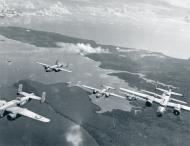
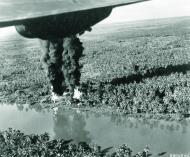
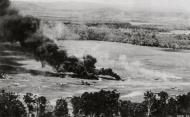
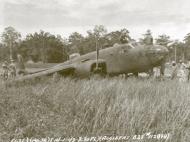
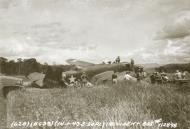
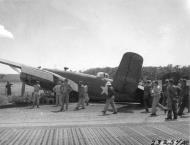
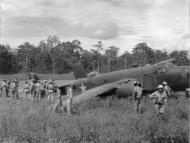
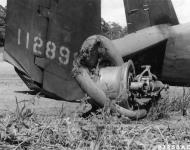

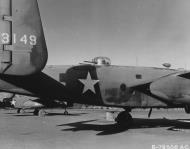
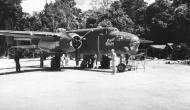
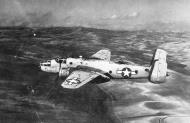
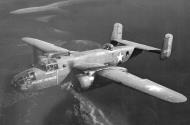
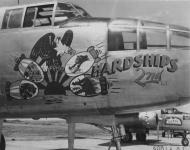
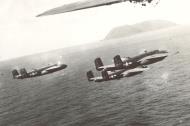


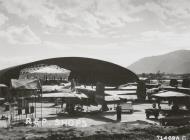
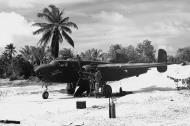


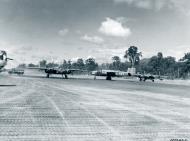
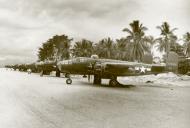
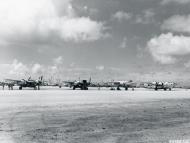
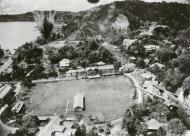




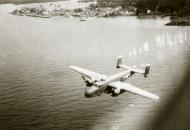


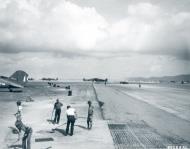
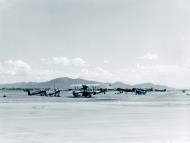
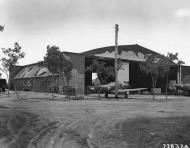
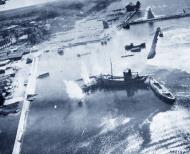
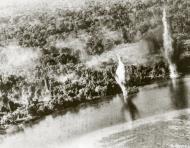
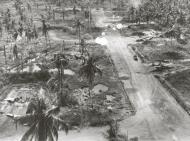
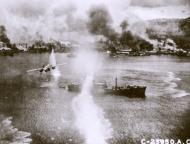
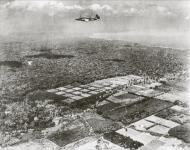
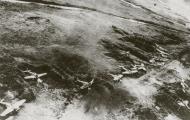
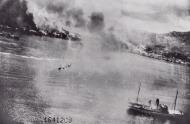

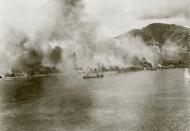
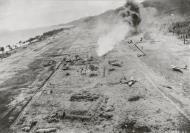
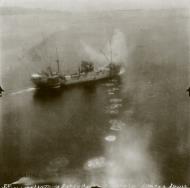
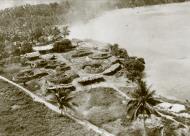
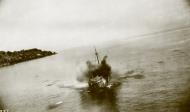
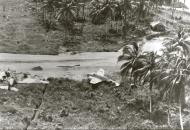

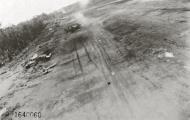
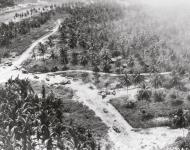
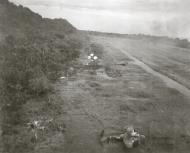
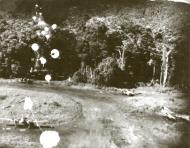
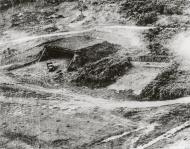
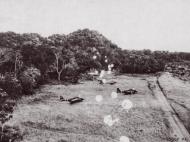
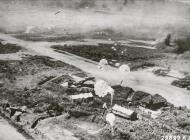

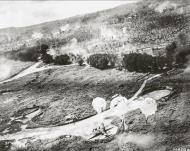

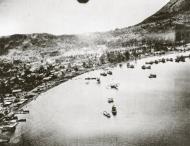
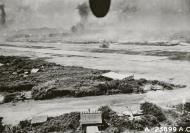

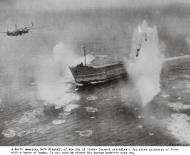
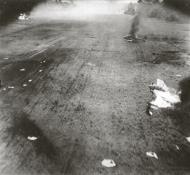

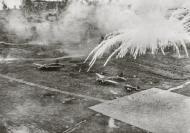
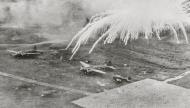
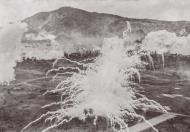
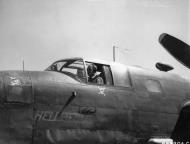
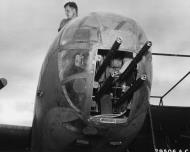
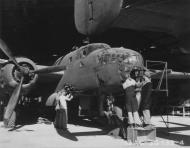
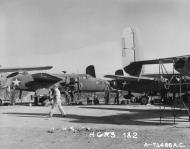
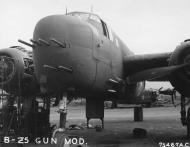
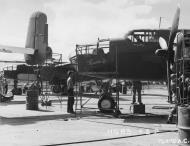
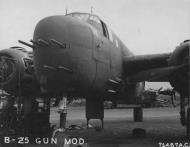
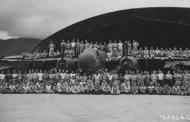


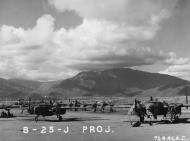
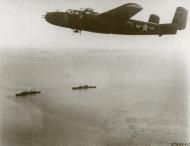
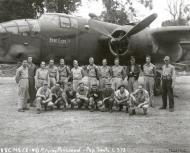
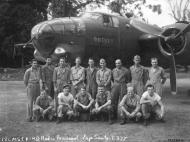
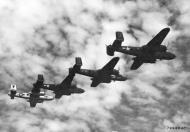
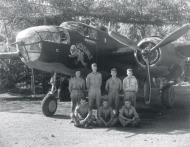
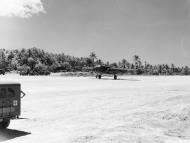
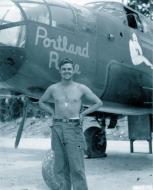
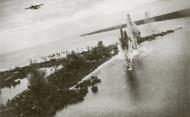

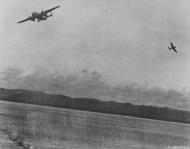

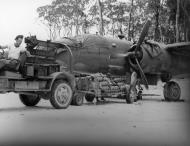
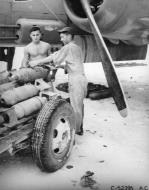

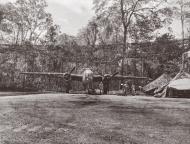
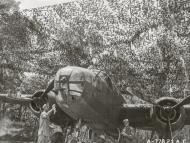
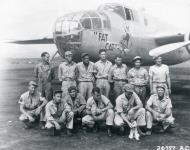
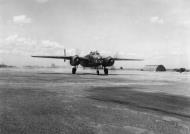
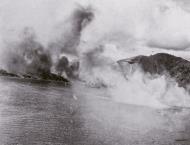
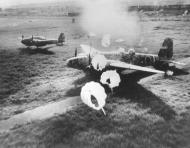
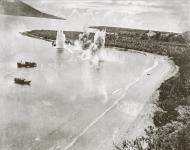

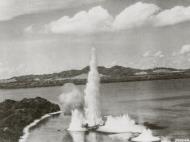
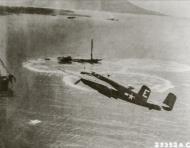
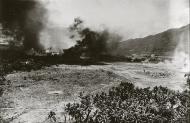
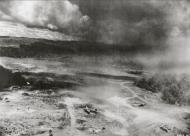
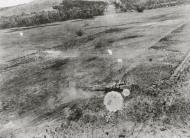
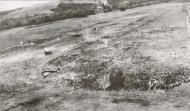
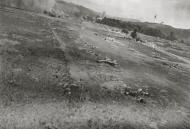
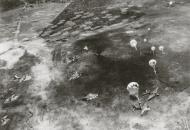

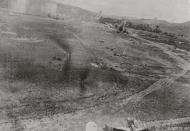

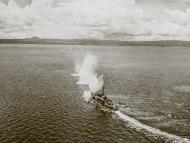


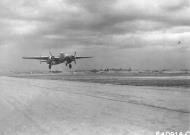
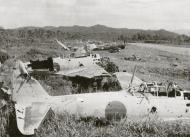
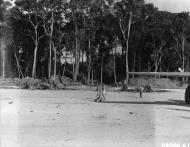
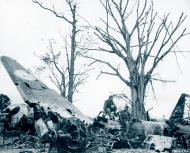

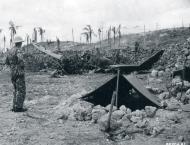
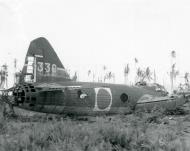
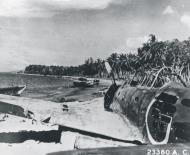

-sunk-Task-Force-38-Manila-Luzon-Philippines-13th-Nov-1944-NA192.jpg)
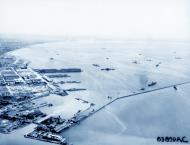
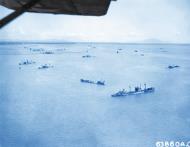
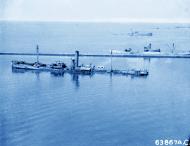
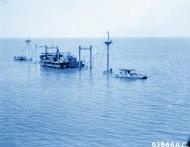
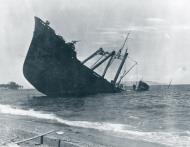
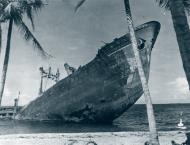
-sunk-Task-Force-38-Manila-Luzon-Philippines-13th-Nov-1944-NA320.jpg)
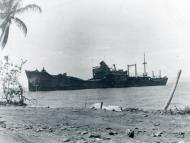
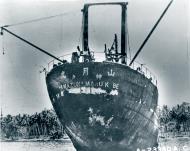
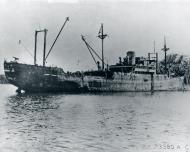

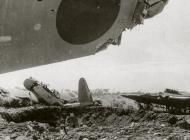
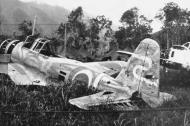
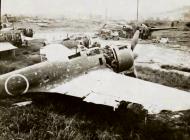
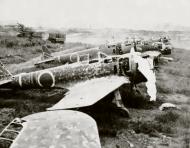
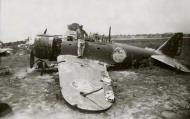
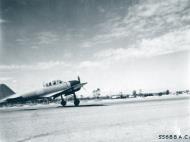
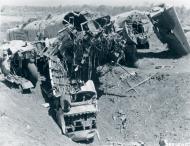
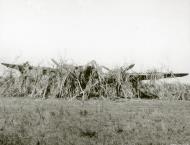
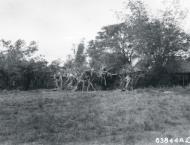
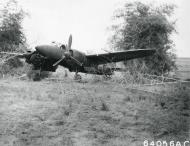
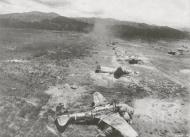
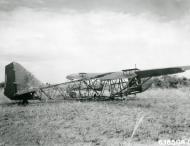
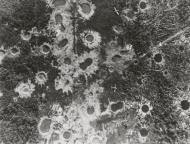
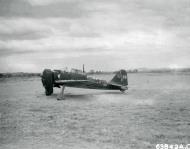
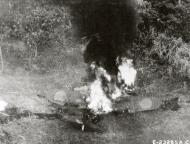
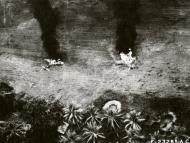
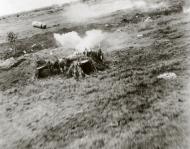
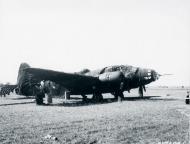
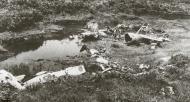
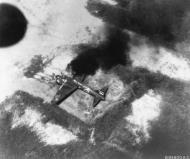
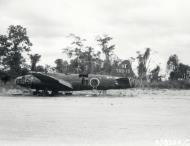

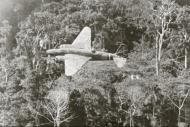
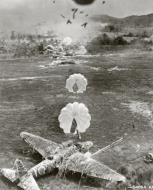
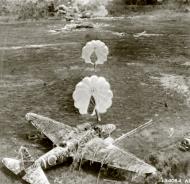
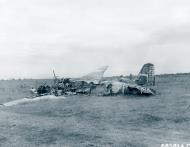
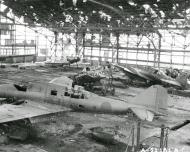
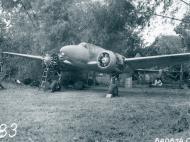
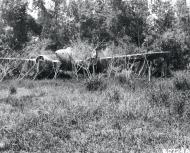
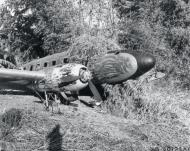
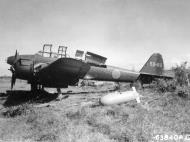
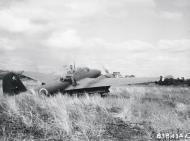
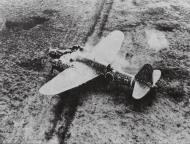

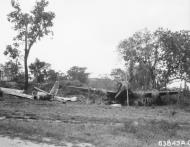
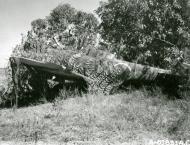
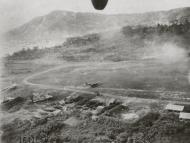
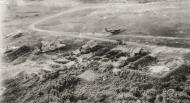
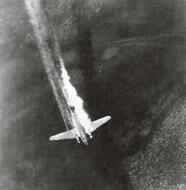
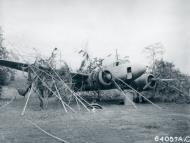
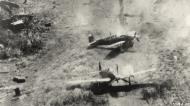

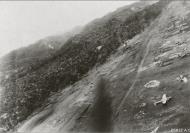
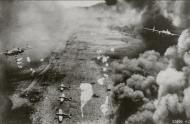
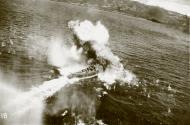
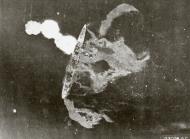
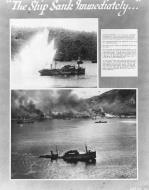
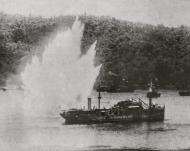
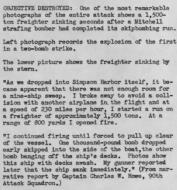
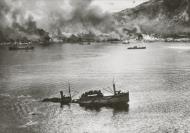
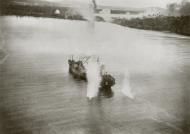

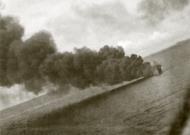
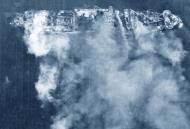
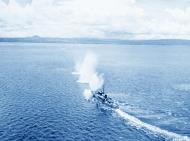
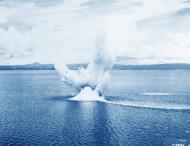
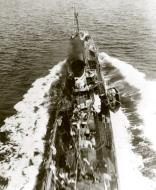
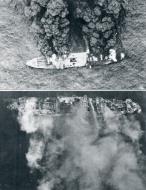
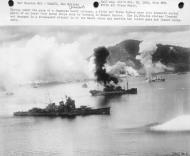
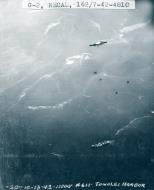
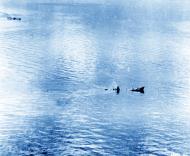

-seaplane-destroyed-on-Makin-Island-Gilbert-Islands-Dec-1943-01.jpg)
